Strategic Information System - Assignment Solution
VerifiedAdded on 2021/06/16
|19
|5157
|37
AI Summary
Contribute Materials
Your contribution can guide someone’s learning journey. Share your
documents today.
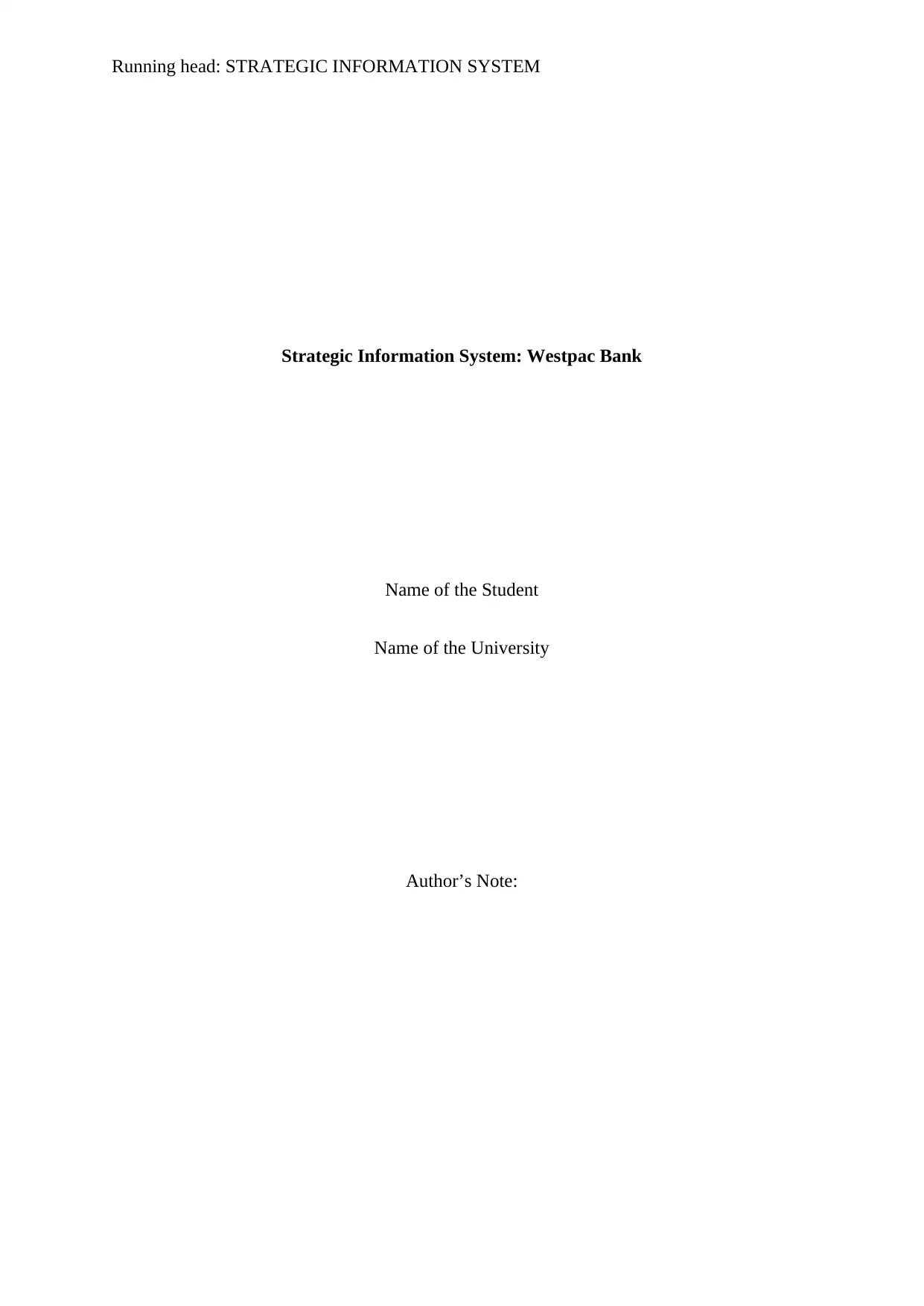
Running head: STRATEGIC INFORMATION SYSTEM
Strategic Information System: Westpac Bank
Name of the Student
Name of the University
Author’s Note:
Strategic Information System: Westpac Bank
Name of the Student
Name of the University
Author’s Note:
Secure Best Marks with AI Grader
Need help grading? Try our AI Grader for instant feedback on your assignments.
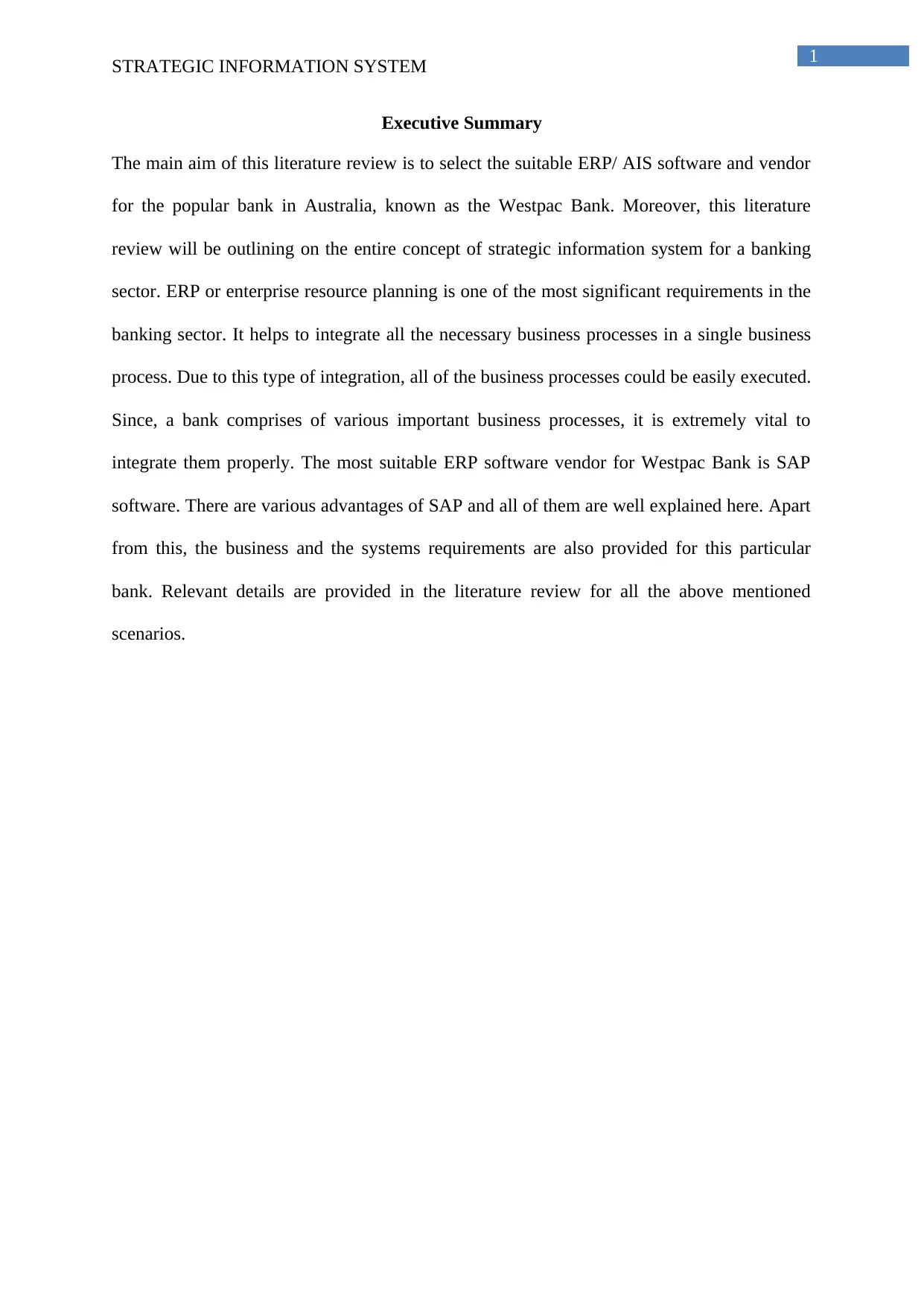
1
STRATEGIC INFORMATION SYSTEM
Executive Summary
The main aim of this literature review is to select the suitable ERP/ AIS software and vendor
for the popular bank in Australia, known as the Westpac Bank. Moreover, this literature
review will be outlining on the entire concept of strategic information system for a banking
sector. ERP or enterprise resource planning is one of the most significant requirements in the
banking sector. It helps to integrate all the necessary business processes in a single business
process. Due to this type of integration, all of the business processes could be easily executed.
Since, a bank comprises of various important business processes, it is extremely vital to
integrate them properly. The most suitable ERP software vendor for Westpac Bank is SAP
software. There are various advantages of SAP and all of them are well explained here. Apart
from this, the business and the systems requirements are also provided for this particular
bank. Relevant details are provided in the literature review for all the above mentioned
scenarios.
STRATEGIC INFORMATION SYSTEM
Executive Summary
The main aim of this literature review is to select the suitable ERP/ AIS software and vendor
for the popular bank in Australia, known as the Westpac Bank. Moreover, this literature
review will be outlining on the entire concept of strategic information system for a banking
sector. ERP or enterprise resource planning is one of the most significant requirements in the
banking sector. It helps to integrate all the necessary business processes in a single business
process. Due to this type of integration, all of the business processes could be easily executed.
Since, a bank comprises of various important business processes, it is extremely vital to
integrate them properly. The most suitable ERP software vendor for Westpac Bank is SAP
software. There are various advantages of SAP and all of them are well explained here. Apart
from this, the business and the systems requirements are also provided for this particular
bank. Relevant details are provided in the literature review for all the above mentioned
scenarios.
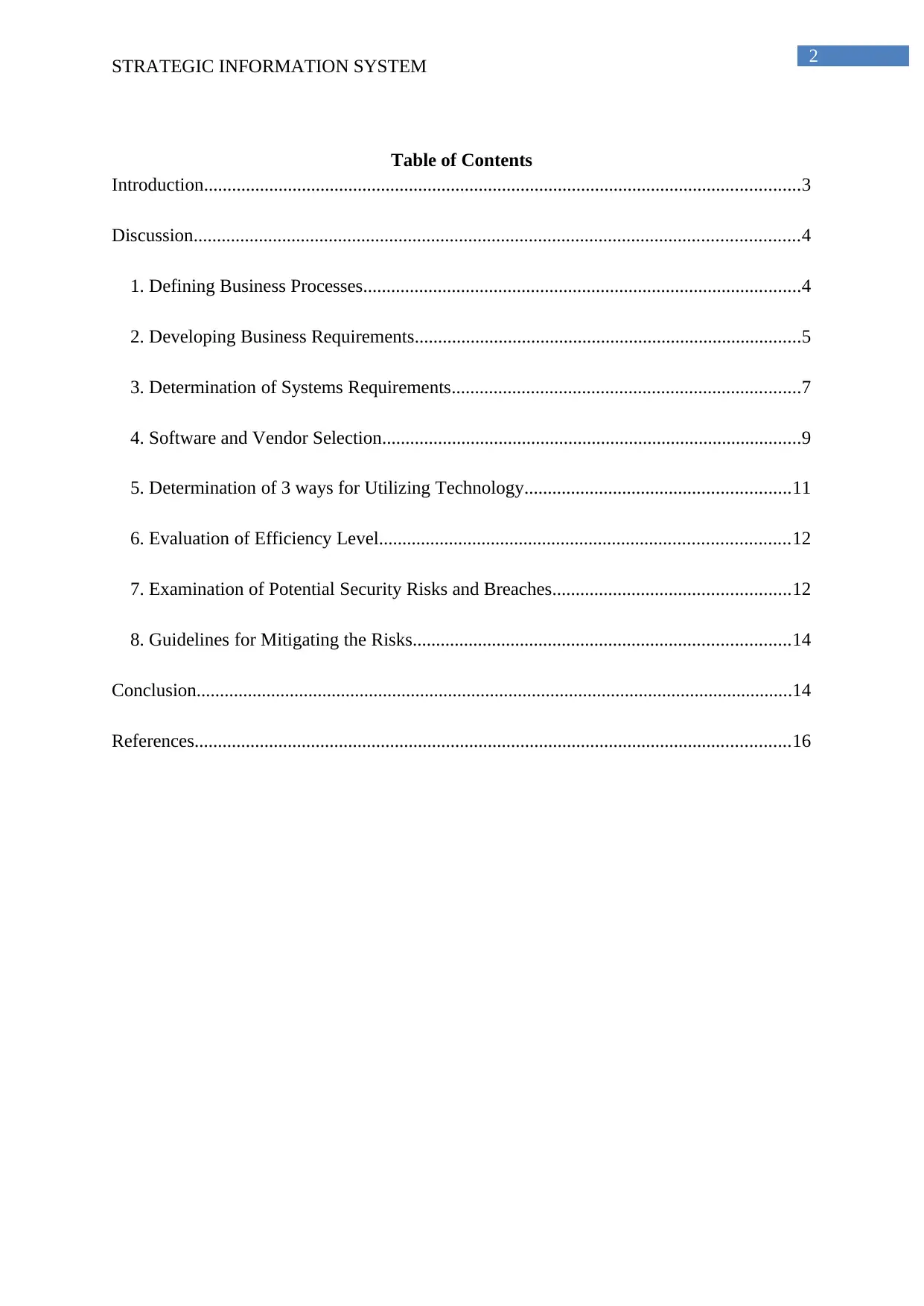
2
STRATEGIC INFORMATION SYSTEM
Table of Contents
Introduction................................................................................................................................3
Discussion..................................................................................................................................4
1. Defining Business Processes..............................................................................................4
2. Developing Business Requirements...................................................................................5
3. Determination of Systems Requirements...........................................................................7
4. Software and Vendor Selection..........................................................................................9
5. Determination of 3 ways for Utilizing Technology.........................................................11
6. Evaluation of Efficiency Level........................................................................................12
7. Examination of Potential Security Risks and Breaches...................................................12
8. Guidelines for Mitigating the Risks.................................................................................14
Conclusion................................................................................................................................14
References................................................................................................................................16
STRATEGIC INFORMATION SYSTEM
Table of Contents
Introduction................................................................................................................................3
Discussion..................................................................................................................................4
1. Defining Business Processes..............................................................................................4
2. Developing Business Requirements...................................................................................5
3. Determination of Systems Requirements...........................................................................7
4. Software and Vendor Selection..........................................................................................9
5. Determination of 3 ways for Utilizing Technology.........................................................11
6. Evaluation of Efficiency Level........................................................................................12
7. Examination of Potential Security Risks and Breaches...................................................12
8. Guidelines for Mitigating the Risks.................................................................................14
Conclusion................................................................................................................................14
References................................................................................................................................16
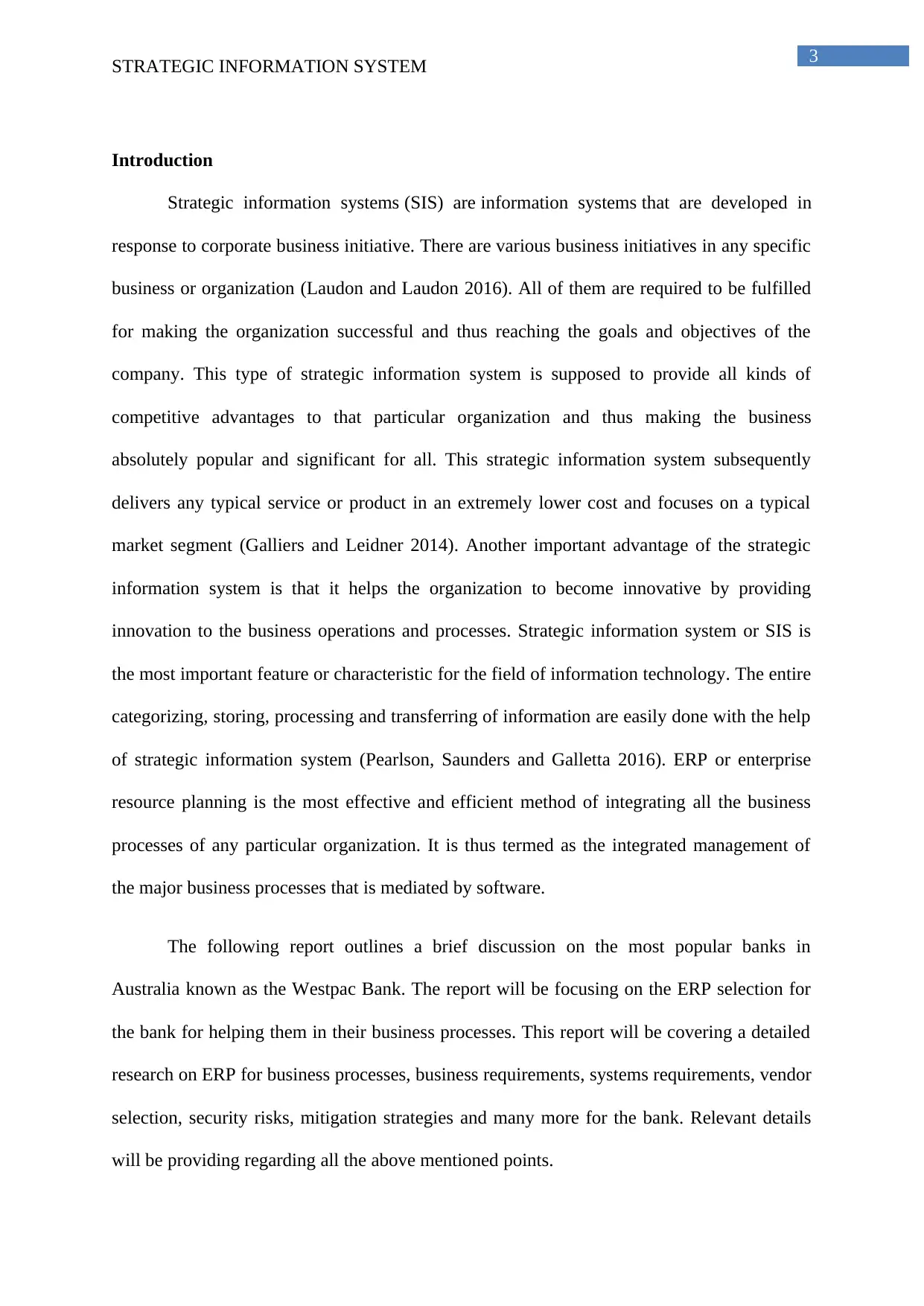
3
STRATEGIC INFORMATION SYSTEM
Introduction
Strategic information systems (SIS) are information systems that are developed in
response to corporate business initiative. There are various business initiatives in any specific
business or organization (Laudon and Laudon 2016). All of them are required to be fulfilled
for making the organization successful and thus reaching the goals and objectives of the
company. This type of strategic information system is supposed to provide all kinds of
competitive advantages to that particular organization and thus making the business
absolutely popular and significant for all. This strategic information system subsequently
delivers any typical service or product in an extremely lower cost and focuses on a typical
market segment (Galliers and Leidner 2014). Another important advantage of the strategic
information system is that it helps the organization to become innovative by providing
innovation to the business operations and processes. Strategic information system or SIS is
the most important feature or characteristic for the field of information technology. The entire
categorizing, storing, processing and transferring of information are easily done with the help
of strategic information system (Pearlson, Saunders and Galletta 2016). ERP or enterprise
resource planning is the most effective and efficient method of integrating all the business
processes of any particular organization. It is thus termed as the integrated management of
the major business processes that is mediated by software.
The following report outlines a brief discussion on the most popular banks in
Australia known as the Westpac Bank. The report will be focusing on the ERP selection for
the bank for helping them in their business processes. This report will be covering a detailed
research on ERP for business processes, business requirements, systems requirements, vendor
selection, security risks, mitigation strategies and many more for the bank. Relevant details
will be providing regarding all the above mentioned points.
STRATEGIC INFORMATION SYSTEM
Introduction
Strategic information systems (SIS) are information systems that are developed in
response to corporate business initiative. There are various business initiatives in any specific
business or organization (Laudon and Laudon 2016). All of them are required to be fulfilled
for making the organization successful and thus reaching the goals and objectives of the
company. This type of strategic information system is supposed to provide all kinds of
competitive advantages to that particular organization and thus making the business
absolutely popular and significant for all. This strategic information system subsequently
delivers any typical service or product in an extremely lower cost and focuses on a typical
market segment (Galliers and Leidner 2014). Another important advantage of the strategic
information system is that it helps the organization to become innovative by providing
innovation to the business operations and processes. Strategic information system or SIS is
the most important feature or characteristic for the field of information technology. The entire
categorizing, storing, processing and transferring of information are easily done with the help
of strategic information system (Pearlson, Saunders and Galletta 2016). ERP or enterprise
resource planning is the most effective and efficient method of integrating all the business
processes of any particular organization. It is thus termed as the integrated management of
the major business processes that is mediated by software.
The following report outlines a brief discussion on the most popular banks in
Australia known as the Westpac Bank. The report will be focusing on the ERP selection for
the bank for helping them in their business processes. This report will be covering a detailed
research on ERP for business processes, business requirements, systems requirements, vendor
selection, security risks, mitigation strategies and many more for the bank. Relevant details
will be providing regarding all the above mentioned points.
Secure Best Marks with AI Grader
Need help grading? Try our AI Grader for instant feedback on your assignments.
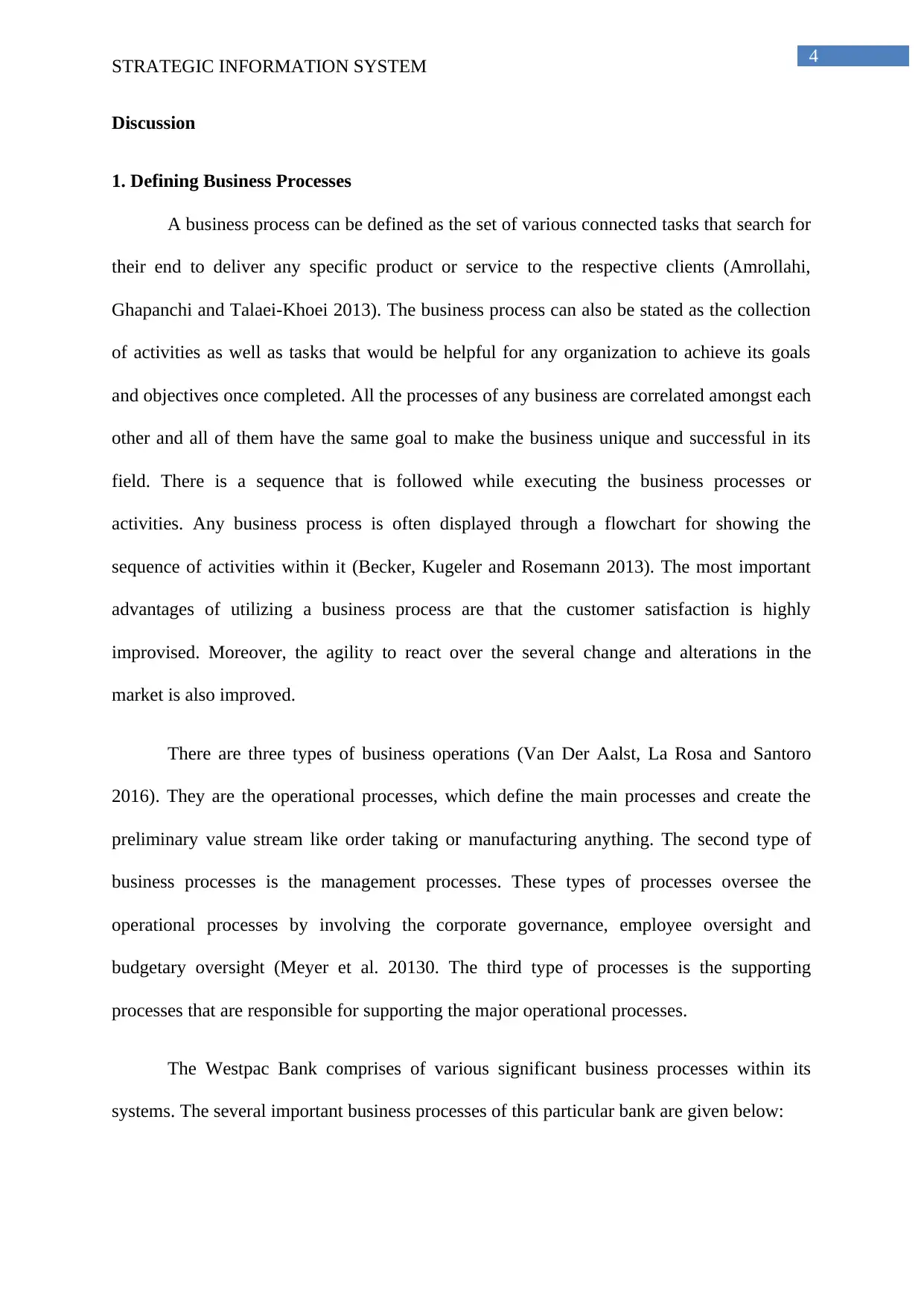
4
STRATEGIC INFORMATION SYSTEM
Discussion
1. Defining Business Processes
A business process can be defined as the set of various connected tasks that search for
their end to deliver any specific product or service to the respective clients (Amrollahi,
Ghapanchi and Talaei-Khoei 2013). The business process can also be stated as the collection
of activities as well as tasks that would be helpful for any organization to achieve its goals
and objectives once completed. All the processes of any business are correlated amongst each
other and all of them have the same goal to make the business unique and successful in its
field. There is a sequence that is followed while executing the business processes or
activities. Any business process is often displayed through a flowchart for showing the
sequence of activities within it (Becker, Kugeler and Rosemann 2013). The most important
advantages of utilizing a business process are that the customer satisfaction is highly
improvised. Moreover, the agility to react over the several change and alterations in the
market is also improved.
There are three types of business operations (Van Der Aalst, La Rosa and Santoro
2016). They are the operational processes, which define the main processes and create the
preliminary value stream like order taking or manufacturing anything. The second type of
business processes is the management processes. These types of processes oversee the
operational processes by involving the corporate governance, employee oversight and
budgetary oversight (Meyer et al. 20130. The third type of processes is the supporting
processes that are responsible for supporting the major operational processes.
The Westpac Bank comprises of various significant business processes within its
systems. The several important business processes of this particular bank are given below:
STRATEGIC INFORMATION SYSTEM
Discussion
1. Defining Business Processes
A business process can be defined as the set of various connected tasks that search for
their end to deliver any specific product or service to the respective clients (Amrollahi,
Ghapanchi and Talaei-Khoei 2013). The business process can also be stated as the collection
of activities as well as tasks that would be helpful for any organization to achieve its goals
and objectives once completed. All the processes of any business are correlated amongst each
other and all of them have the same goal to make the business unique and successful in its
field. There is a sequence that is followed while executing the business processes or
activities. Any business process is often displayed through a flowchart for showing the
sequence of activities within it (Becker, Kugeler and Rosemann 2013). The most important
advantages of utilizing a business process are that the customer satisfaction is highly
improvised. Moreover, the agility to react over the several change and alterations in the
market is also improved.
There are three types of business operations (Van Der Aalst, La Rosa and Santoro
2016). They are the operational processes, which define the main processes and create the
preliminary value stream like order taking or manufacturing anything. The second type of
business processes is the management processes. These types of processes oversee the
operational processes by involving the corporate governance, employee oversight and
budgetary oversight (Meyer et al. 20130. The third type of processes is the supporting
processes that are responsible for supporting the major operational processes.
The Westpac Bank comprises of various significant business processes within its
systems. The several important business processes of this particular bank are given below:
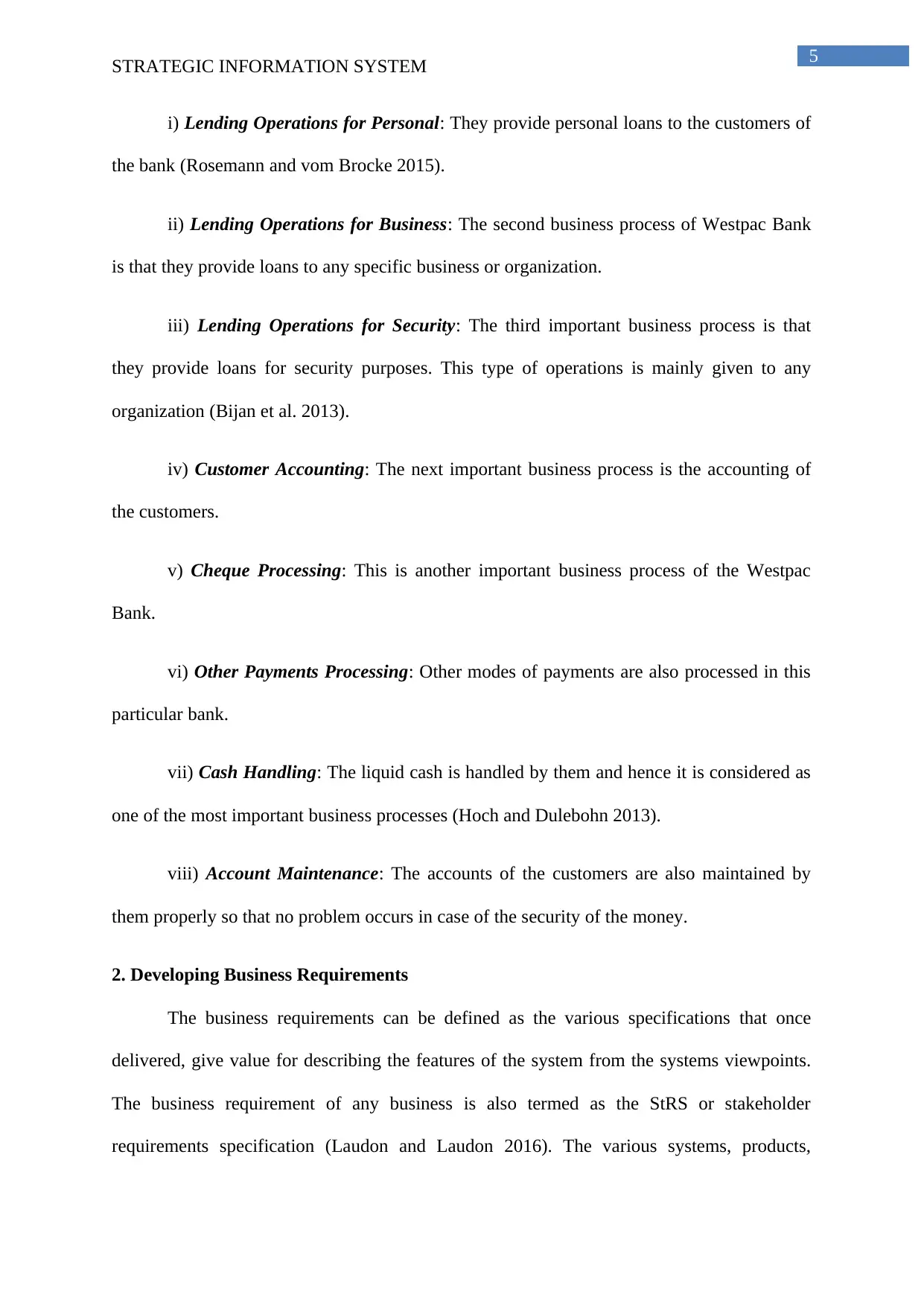
5
STRATEGIC INFORMATION SYSTEM
i) Lending Operations for Personal: They provide personal loans to the customers of
the bank (Rosemann and vom Brocke 2015).
ii) Lending Operations for Business: The second business process of Westpac Bank
is that they provide loans to any specific business or organization.
iii) Lending Operations for Security: The third important business process is that
they provide loans for security purposes. This type of operations is mainly given to any
organization (Bijan et al. 2013).
iv) Customer Accounting: The next important business process is the accounting of
the customers.
v) Cheque Processing: This is another important business process of the Westpac
Bank.
vi) Other Payments Processing: Other modes of payments are also processed in this
particular bank.
vii) Cash Handling: The liquid cash is handled by them and hence it is considered as
one of the most important business processes (Hoch and Dulebohn 2013).
viii) Account Maintenance: The accounts of the customers are also maintained by
them properly so that no problem occurs in case of the security of the money.
2. Developing Business Requirements
The business requirements can be defined as the various specifications that once
delivered, give value for describing the features of the system from the systems viewpoints.
The business requirement of any business is also termed as the StRS or stakeholder
requirements specification (Laudon and Laudon 2016). The various systems, products,
STRATEGIC INFORMATION SYSTEM
i) Lending Operations for Personal: They provide personal loans to the customers of
the bank (Rosemann and vom Brocke 2015).
ii) Lending Operations for Business: The second business process of Westpac Bank
is that they provide loans to any specific business or organization.
iii) Lending Operations for Security: The third important business process is that
they provide loans for security purposes. This type of operations is mainly given to any
organization (Bijan et al. 2013).
iv) Customer Accounting: The next important business process is the accounting of
the customers.
v) Cheque Processing: This is another important business process of the Westpac
Bank.
vi) Other Payments Processing: Other modes of payments are also processed in this
particular bank.
vii) Cash Handling: The liquid cash is handled by them and hence it is considered as
one of the most important business processes (Hoch and Dulebohn 2013).
viii) Account Maintenance: The accounts of the customers are also maintained by
them properly so that no problem occurs in case of the security of the money.
2. Developing Business Requirements
The business requirements can be defined as the various specifications that once
delivered, give value for describing the features of the system from the systems viewpoints.
The business requirement of any business is also termed as the StRS or stakeholder
requirements specification (Laudon and Laudon 2016). The various systems, products,
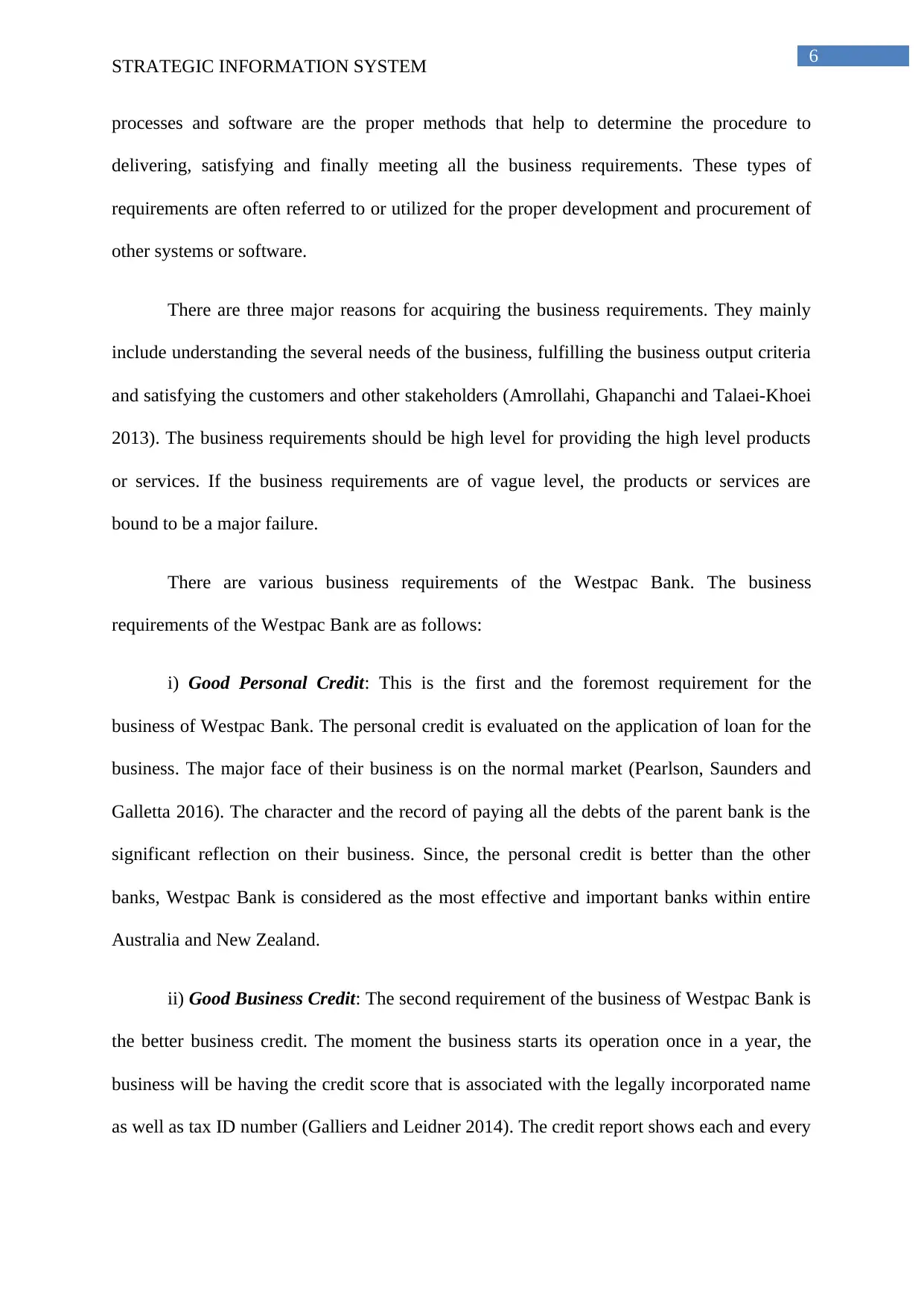
6
STRATEGIC INFORMATION SYSTEM
processes and software are the proper methods that help to determine the procedure to
delivering, satisfying and finally meeting all the business requirements. These types of
requirements are often referred to or utilized for the proper development and procurement of
other systems or software.
There are three major reasons for acquiring the business requirements. They mainly
include understanding the several needs of the business, fulfilling the business output criteria
and satisfying the customers and other stakeholders (Amrollahi, Ghapanchi and Talaei-Khoei
2013). The business requirements should be high level for providing the high level products
or services. If the business requirements are of vague level, the products or services are
bound to be a major failure.
There are various business requirements of the Westpac Bank. The business
requirements of the Westpac Bank are as follows:
i) Good Personal Credit: This is the first and the foremost requirement for the
business of Westpac Bank. The personal credit is evaluated on the application of loan for the
business. The major face of their business is on the normal market (Pearlson, Saunders and
Galletta 2016). The character and the record of paying all the debts of the parent bank is the
significant reflection on their business. Since, the personal credit is better than the other
banks, Westpac Bank is considered as the most effective and important banks within entire
Australia and New Zealand.
ii) Good Business Credit: The second requirement of the business of Westpac Bank is
the better business credit. The moment the business starts its operation once in a year, the
business will be having the credit score that is associated with the legally incorporated name
as well as tax ID number (Galliers and Leidner 2014). The credit report shows each and every
STRATEGIC INFORMATION SYSTEM
processes and software are the proper methods that help to determine the procedure to
delivering, satisfying and finally meeting all the business requirements. These types of
requirements are often referred to or utilized for the proper development and procurement of
other systems or software.
There are three major reasons for acquiring the business requirements. They mainly
include understanding the several needs of the business, fulfilling the business output criteria
and satisfying the customers and other stakeholders (Amrollahi, Ghapanchi and Talaei-Khoei
2013). The business requirements should be high level for providing the high level products
or services. If the business requirements are of vague level, the products or services are
bound to be a major failure.
There are various business requirements of the Westpac Bank. The business
requirements of the Westpac Bank are as follows:
i) Good Personal Credit: This is the first and the foremost requirement for the
business of Westpac Bank. The personal credit is evaluated on the application of loan for the
business. The major face of their business is on the normal market (Pearlson, Saunders and
Galletta 2016). The character and the record of paying all the debts of the parent bank is the
significant reflection on their business. Since, the personal credit is better than the other
banks, Westpac Bank is considered as the most effective and important banks within entire
Australia and New Zealand.
ii) Good Business Credit: The second requirement of the business of Westpac Bank is
the better business credit. The moment the business starts its operation once in a year, the
business will be having the credit score that is associated with the legally incorporated name
as well as tax ID number (Galliers and Leidner 2014). The credit report shows each and every
Paraphrase This Document
Need a fresh take? Get an instant paraphrase of this document with our AI Paraphraser
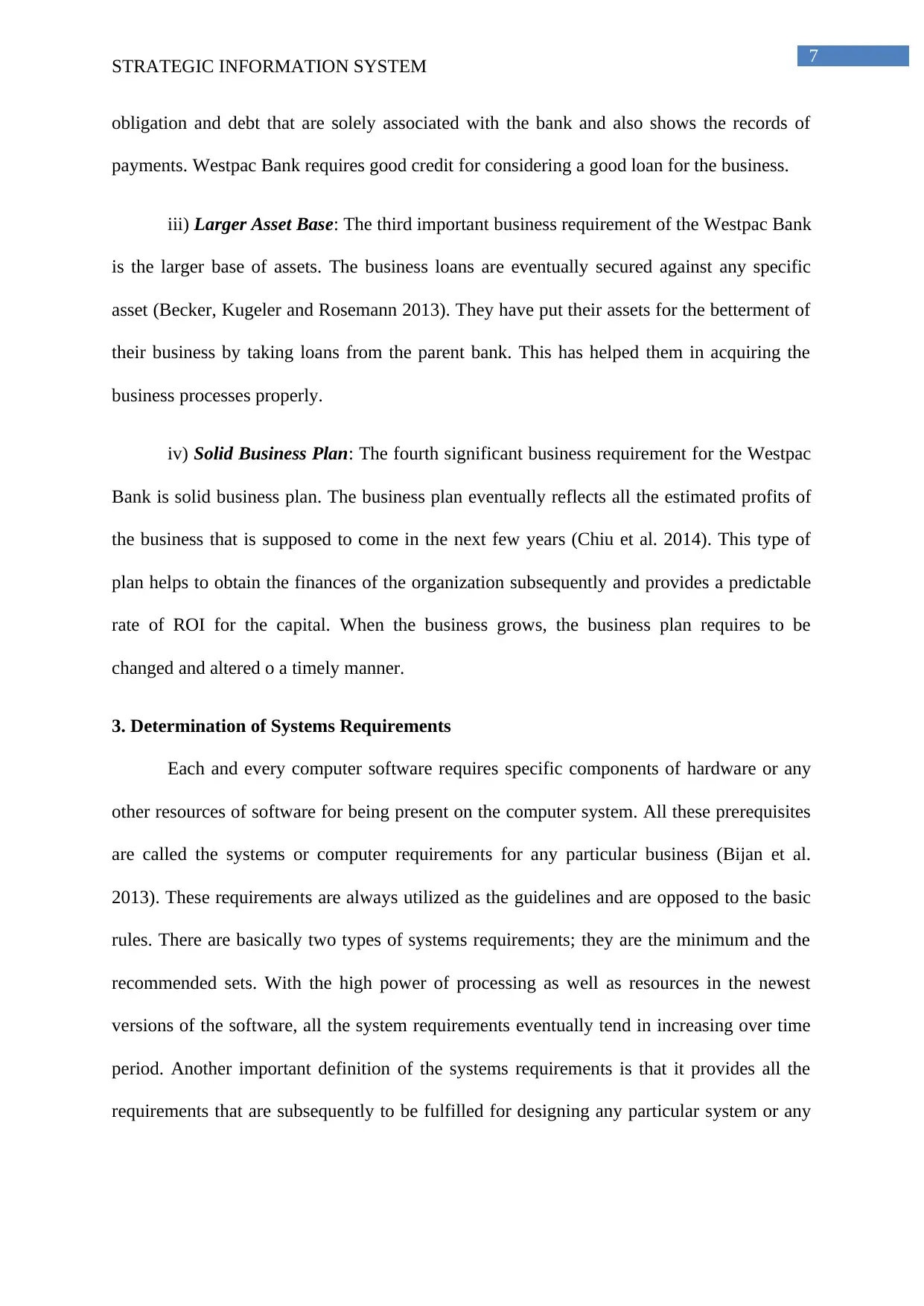
7
STRATEGIC INFORMATION SYSTEM
obligation and debt that are solely associated with the bank and also shows the records of
payments. Westpac Bank requires good credit for considering a good loan for the business.
iii) Larger Asset Base: The third important business requirement of the Westpac Bank
is the larger base of assets. The business loans are eventually secured against any specific
asset (Becker, Kugeler and Rosemann 2013). They have put their assets for the betterment of
their business by taking loans from the parent bank. This has helped them in acquiring the
business processes properly.
iv) Solid Business Plan: The fourth significant business requirement for the Westpac
Bank is solid business plan. The business plan eventually reflects all the estimated profits of
the business that is supposed to come in the next few years (Chiu et al. 2014). This type of
plan helps to obtain the finances of the organization subsequently and provides a predictable
rate of ROI for the capital. When the business grows, the business plan requires to be
changed and altered o a timely manner.
3. Determination of Systems Requirements
Each and every computer software requires specific components of hardware or any
other resources of software for being present on the computer system. All these prerequisites
are called the systems or computer requirements for any particular business (Bijan et al.
2013). These requirements are always utilized as the guidelines and are opposed to the basic
rules. There are basically two types of systems requirements; they are the minimum and the
recommended sets. With the high power of processing as well as resources in the newest
versions of the software, all the system requirements eventually tend in increasing over time
period. Another important definition of the systems requirements is that it provides all the
requirements that are subsequently to be fulfilled for designing any particular system or any
STRATEGIC INFORMATION SYSTEM
obligation and debt that are solely associated with the bank and also shows the records of
payments. Westpac Bank requires good credit for considering a good loan for the business.
iii) Larger Asset Base: The third important business requirement of the Westpac Bank
is the larger base of assets. The business loans are eventually secured against any specific
asset (Becker, Kugeler and Rosemann 2013). They have put their assets for the betterment of
their business by taking loans from the parent bank. This has helped them in acquiring the
business processes properly.
iv) Solid Business Plan: The fourth significant business requirement for the Westpac
Bank is solid business plan. The business plan eventually reflects all the estimated profits of
the business that is supposed to come in the next few years (Chiu et al. 2014). This type of
plan helps to obtain the finances of the organization subsequently and provides a predictable
rate of ROI for the capital. When the business grows, the business plan requires to be
changed and altered o a timely manner.
3. Determination of Systems Requirements
Each and every computer software requires specific components of hardware or any
other resources of software for being present on the computer system. All these prerequisites
are called the systems or computer requirements for any particular business (Bijan et al.
2013). These requirements are always utilized as the guidelines and are opposed to the basic
rules. There are basically two types of systems requirements; they are the minimum and the
recommended sets. With the high power of processing as well as resources in the newest
versions of the software, all the system requirements eventually tend in increasing over time
period. Another important definition of the systems requirements is that it provides all the
requirements that are subsequently to be fulfilled for designing any particular system or any
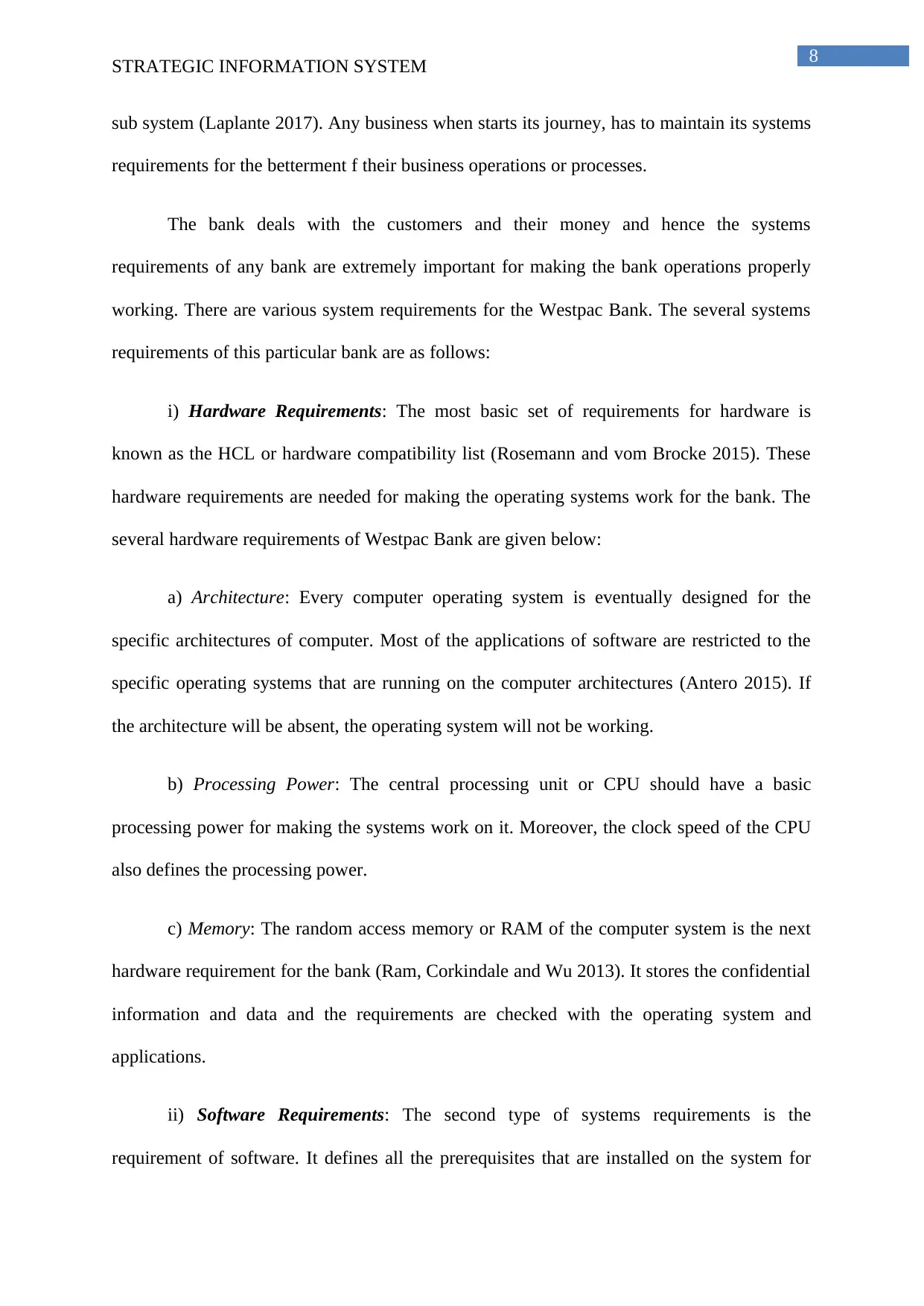
8
STRATEGIC INFORMATION SYSTEM
sub system (Laplante 2017). Any business when starts its journey, has to maintain its systems
requirements for the betterment f their business operations or processes.
The bank deals with the customers and their money and hence the systems
requirements of any bank are extremely important for making the bank operations properly
working. There are various system requirements for the Westpac Bank. The several systems
requirements of this particular bank are as follows:
i) Hardware Requirements: The most basic set of requirements for hardware is
known as the HCL or hardware compatibility list (Rosemann and vom Brocke 2015). These
hardware requirements are needed for making the operating systems work for the bank. The
several hardware requirements of Westpac Bank are given below:
a) Architecture: Every computer operating system is eventually designed for the
specific architectures of computer. Most of the applications of software are restricted to the
specific operating systems that are running on the computer architectures (Antero 2015). If
the architecture will be absent, the operating system will not be working.
b) Processing Power: The central processing unit or CPU should have a basic
processing power for making the systems work on it. Moreover, the clock speed of the CPU
also defines the processing power.
c) Memory: The random access memory or RAM of the computer system is the next
hardware requirement for the bank (Ram, Corkindale and Wu 2013). It stores the confidential
information and data and the requirements are checked with the operating system and
applications.
ii) Software Requirements: The second type of systems requirements is the
requirement of software. It defines all the prerequisites that are installed on the system for
STRATEGIC INFORMATION SYSTEM
sub system (Laplante 2017). Any business when starts its journey, has to maintain its systems
requirements for the betterment f their business operations or processes.
The bank deals with the customers and their money and hence the systems
requirements of any bank are extremely important for making the bank operations properly
working. There are various system requirements for the Westpac Bank. The several systems
requirements of this particular bank are as follows:
i) Hardware Requirements: The most basic set of requirements for hardware is
known as the HCL or hardware compatibility list (Rosemann and vom Brocke 2015). These
hardware requirements are needed for making the operating systems work for the bank. The
several hardware requirements of Westpac Bank are given below:
a) Architecture: Every computer operating system is eventually designed for the
specific architectures of computer. Most of the applications of software are restricted to the
specific operating systems that are running on the computer architectures (Antero 2015). If
the architecture will be absent, the operating system will not be working.
b) Processing Power: The central processing unit or CPU should have a basic
processing power for making the systems work on it. Moreover, the clock speed of the CPU
also defines the processing power.
c) Memory: The random access memory or RAM of the computer system is the next
hardware requirement for the bank (Ram, Corkindale and Wu 2013). It stores the confidential
information and data and the requirements are checked with the operating system and
applications.
ii) Software Requirements: The second type of systems requirements is the
requirement of software. It defines all the prerequisites that are installed on the system for
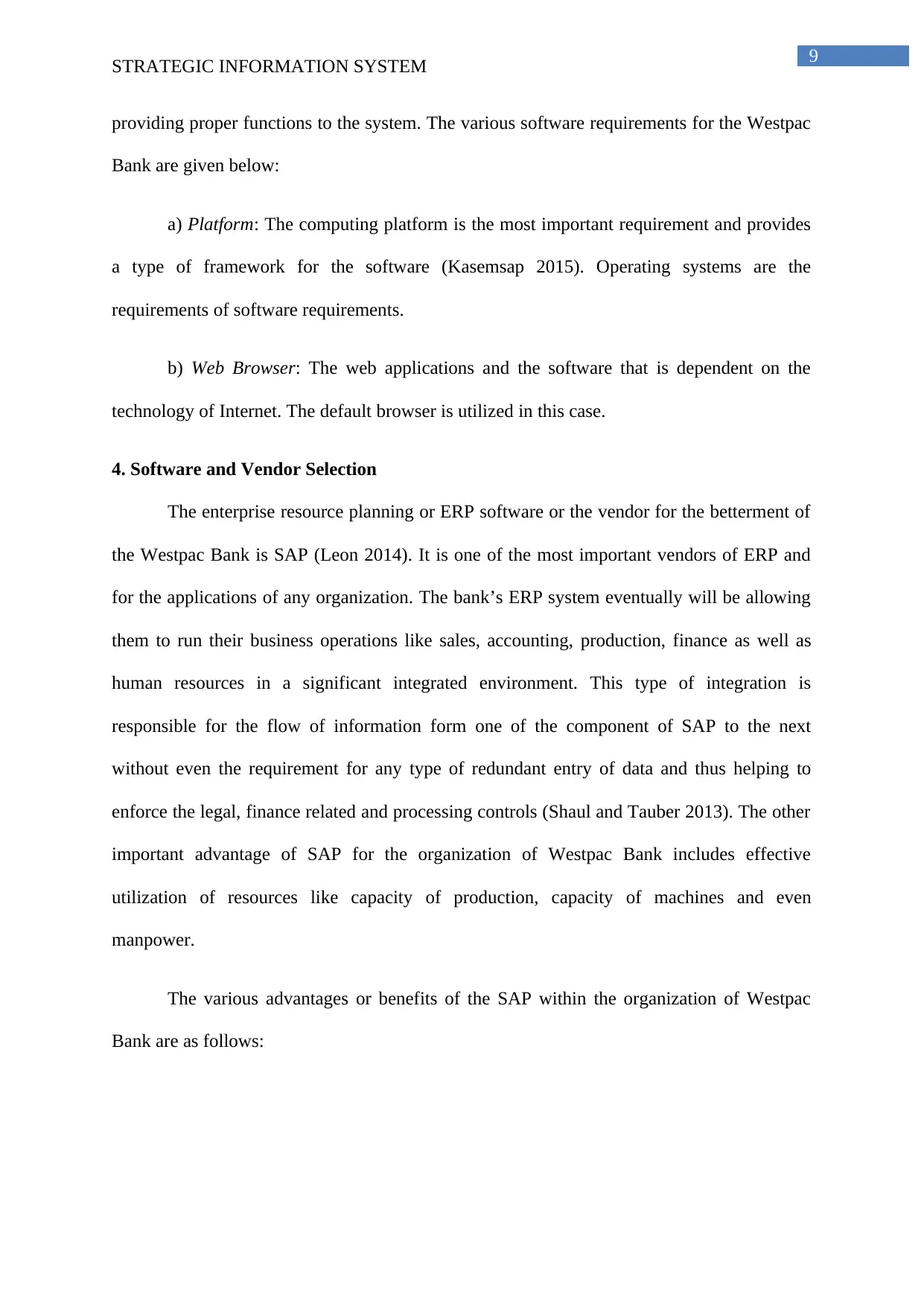
9
STRATEGIC INFORMATION SYSTEM
providing proper functions to the system. The various software requirements for the Westpac
Bank are given below:
a) Platform: The computing platform is the most important requirement and provides
a type of framework for the software (Kasemsap 2015). Operating systems are the
requirements of software requirements.
b) Web Browser: The web applications and the software that is dependent on the
technology of Internet. The default browser is utilized in this case.
4. Software and Vendor Selection
The enterprise resource planning or ERP software or the vendor for the betterment of
the Westpac Bank is SAP (Leon 2014). It is one of the most important vendors of ERP and
for the applications of any organization. The bank’s ERP system eventually will be allowing
them to run their business operations like sales, accounting, production, finance as well as
human resources in a significant integrated environment. This type of integration is
responsible for the flow of information form one of the component of SAP to the next
without even the requirement for any type of redundant entry of data and thus helping to
enforce the legal, finance related and processing controls (Shaul and Tauber 2013). The other
important advantage of SAP for the organization of Westpac Bank includes effective
utilization of resources like capacity of production, capacity of machines and even
manpower.
The various advantages or benefits of the SAP within the organization of Westpac
Bank are as follows:
STRATEGIC INFORMATION SYSTEM
providing proper functions to the system. The various software requirements for the Westpac
Bank are given below:
a) Platform: The computing platform is the most important requirement and provides
a type of framework for the software (Kasemsap 2015). Operating systems are the
requirements of software requirements.
b) Web Browser: The web applications and the software that is dependent on the
technology of Internet. The default browser is utilized in this case.
4. Software and Vendor Selection
The enterprise resource planning or ERP software or the vendor for the betterment of
the Westpac Bank is SAP (Leon 2014). It is one of the most important vendors of ERP and
for the applications of any organization. The bank’s ERP system eventually will be allowing
them to run their business operations like sales, accounting, production, finance as well as
human resources in a significant integrated environment. This type of integration is
responsible for the flow of information form one of the component of SAP to the next
without even the requirement for any type of redundant entry of data and thus helping to
enforce the legal, finance related and processing controls (Shaul and Tauber 2013). The other
important advantage of SAP for the organization of Westpac Bank includes effective
utilization of resources like capacity of production, capacity of machines and even
manpower.
The various advantages or benefits of the SAP within the organization of Westpac
Bank are as follows:
Secure Best Marks with AI Grader
Need help grading? Try our AI Grader for instant feedback on your assignments.
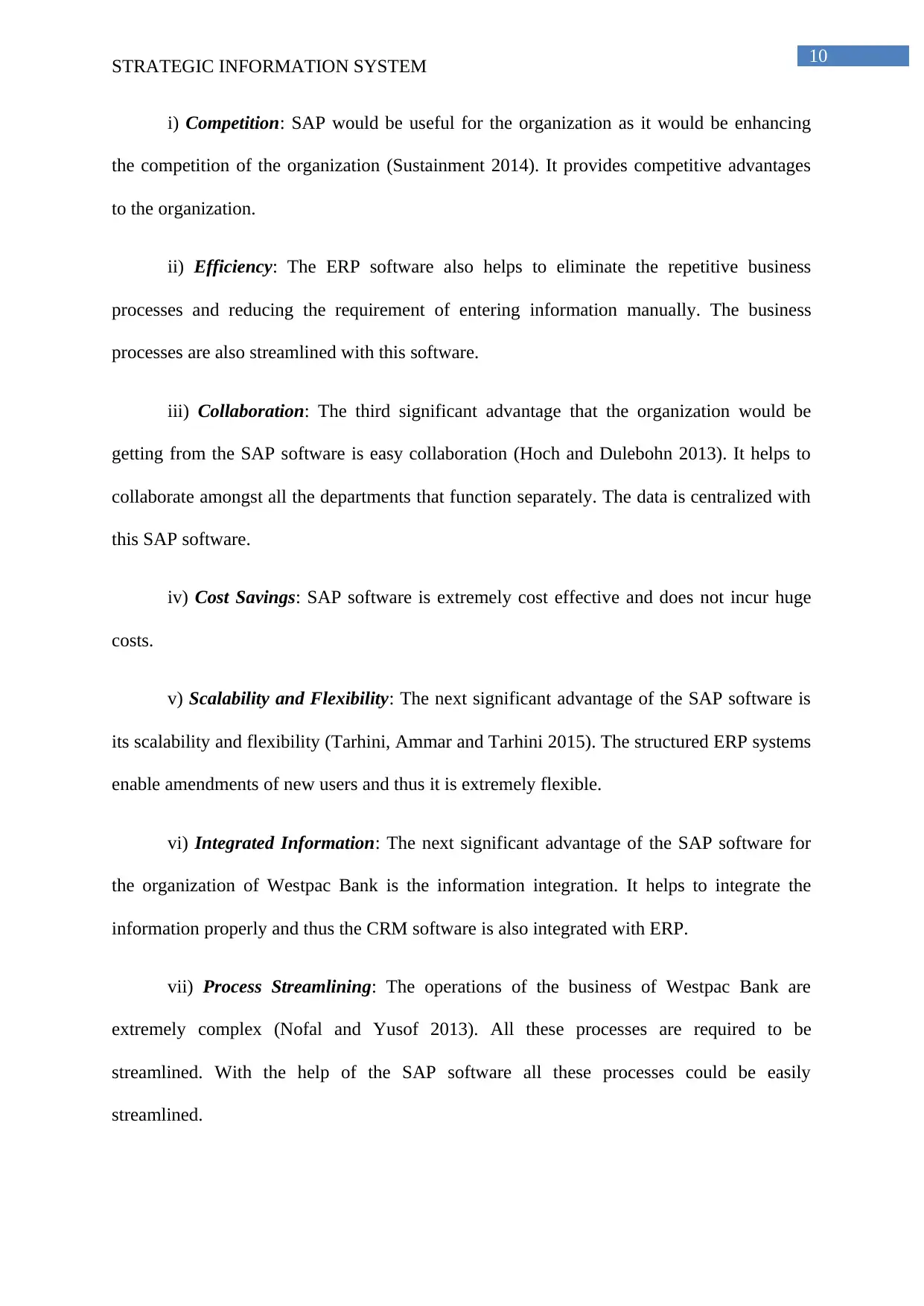
10
STRATEGIC INFORMATION SYSTEM
i) Competition: SAP would be useful for the organization as it would be enhancing
the competition of the organization (Sustainment 2014). It provides competitive advantages
to the organization.
ii) Efficiency: The ERP software also helps to eliminate the repetitive business
processes and reducing the requirement of entering information manually. The business
processes are also streamlined with this software.
iii) Collaboration: The third significant advantage that the organization would be
getting from the SAP software is easy collaboration (Hoch and Dulebohn 2013). It helps to
collaborate amongst all the departments that function separately. The data is centralized with
this SAP software.
iv) Cost Savings: SAP software is extremely cost effective and does not incur huge
costs.
v) Scalability and Flexibility: The next significant advantage of the SAP software is
its scalability and flexibility (Tarhini, Ammar and Tarhini 2015). The structured ERP systems
enable amendments of new users and thus it is extremely flexible.
vi) Integrated Information: The next significant advantage of the SAP software for
the organization of Westpac Bank is the information integration. It helps to integrate the
information properly and thus the CRM software is also integrated with ERP.
vii) Process Streamlining: The operations of the business of Westpac Bank are
extremely complex (Nofal and Yusof 2013). All these processes are required to be
streamlined. With the help of the SAP software all these processes could be easily
streamlined.
STRATEGIC INFORMATION SYSTEM
i) Competition: SAP would be useful for the organization as it would be enhancing
the competition of the organization (Sustainment 2014). It provides competitive advantages
to the organization.
ii) Efficiency: The ERP software also helps to eliminate the repetitive business
processes and reducing the requirement of entering information manually. The business
processes are also streamlined with this software.
iii) Collaboration: The third significant advantage that the organization would be
getting from the SAP software is easy collaboration (Hoch and Dulebohn 2013). It helps to
collaborate amongst all the departments that function separately. The data is centralized with
this SAP software.
iv) Cost Savings: SAP software is extremely cost effective and does not incur huge
costs.
v) Scalability and Flexibility: The next significant advantage of the SAP software is
its scalability and flexibility (Tarhini, Ammar and Tarhini 2015). The structured ERP systems
enable amendments of new users and thus it is extremely flexible.
vi) Integrated Information: The next significant advantage of the SAP software for
the organization of Westpac Bank is the information integration. It helps to integrate the
information properly and thus the CRM software is also integrated with ERP.
vii) Process Streamlining: The operations of the business of Westpac Bank are
extremely complex (Nofal and Yusof 2013). All these processes are required to be
streamlined. With the help of the SAP software all these processes could be easily
streamlined.
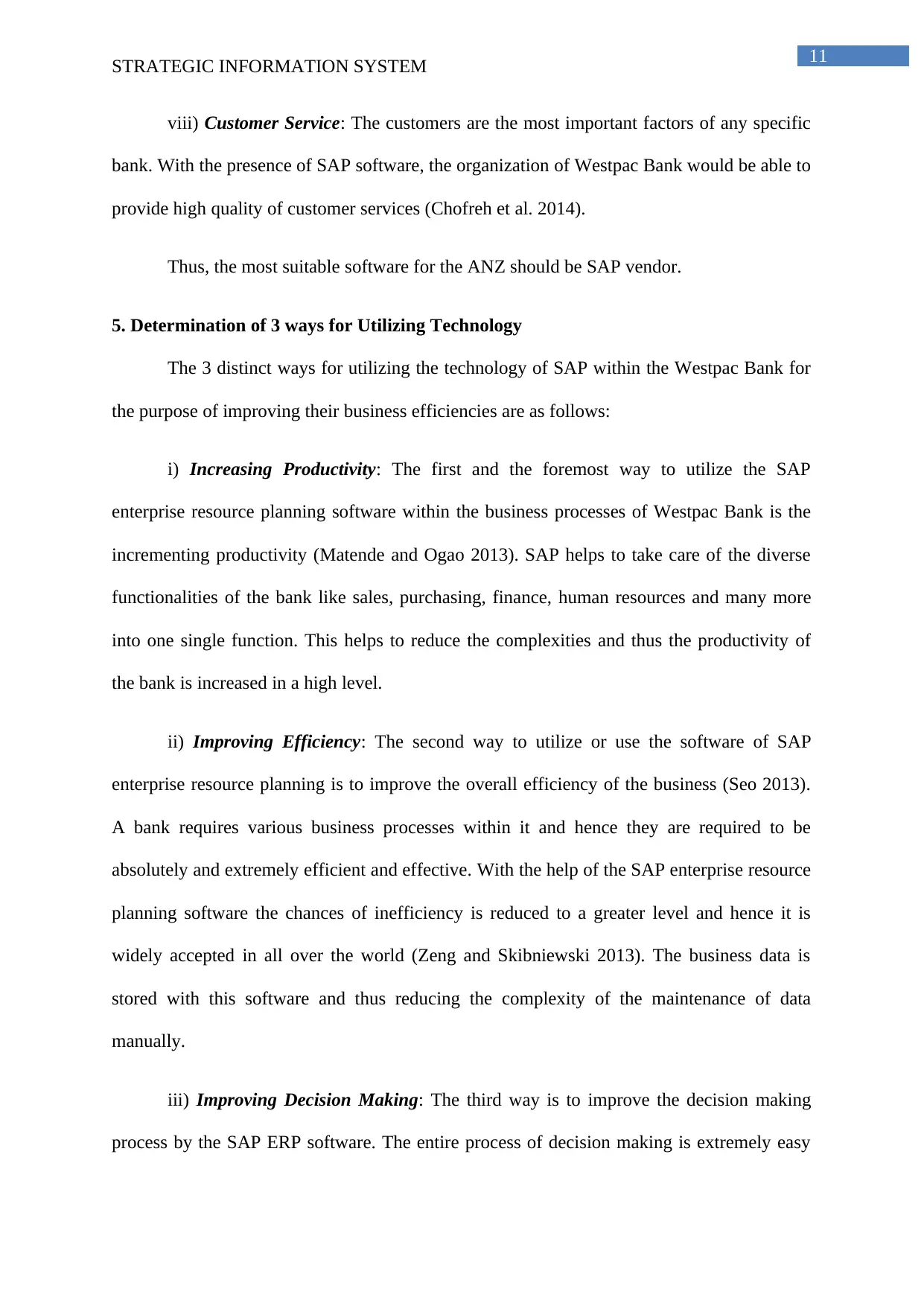
11
STRATEGIC INFORMATION SYSTEM
viii) Customer Service: The customers are the most important factors of any specific
bank. With the presence of SAP software, the organization of Westpac Bank would be able to
provide high quality of customer services (Chofreh et al. 2014).
Thus, the most suitable software for the ANZ should be SAP vendor.
5. Determination of 3 ways for Utilizing Technology
The 3 distinct ways for utilizing the technology of SAP within the Westpac Bank for
the purpose of improving their business efficiencies are as follows:
i) Increasing Productivity: The first and the foremost way to utilize the SAP
enterprise resource planning software within the business processes of Westpac Bank is the
incrementing productivity (Matende and Ogao 2013). SAP helps to take care of the diverse
functionalities of the bank like sales, purchasing, finance, human resources and many more
into one single function. This helps to reduce the complexities and thus the productivity of
the bank is increased in a high level.
ii) Improving Efficiency: The second way to utilize or use the software of SAP
enterprise resource planning is to improve the overall efficiency of the business (Seo 2013).
A bank requires various business processes within it and hence they are required to be
absolutely and extremely efficient and effective. With the help of the SAP enterprise resource
planning software the chances of inefficiency is reduced to a greater level and hence it is
widely accepted in all over the world (Zeng and Skibniewski 2013). The business data is
stored with this software and thus reducing the complexity of the maintenance of data
manually.
iii) Improving Decision Making: The third way is to improve the decision making
process by the SAP ERP software. The entire process of decision making is extremely easy
STRATEGIC INFORMATION SYSTEM
viii) Customer Service: The customers are the most important factors of any specific
bank. With the presence of SAP software, the organization of Westpac Bank would be able to
provide high quality of customer services (Chofreh et al. 2014).
Thus, the most suitable software for the ANZ should be SAP vendor.
5. Determination of 3 ways for Utilizing Technology
The 3 distinct ways for utilizing the technology of SAP within the Westpac Bank for
the purpose of improving their business efficiencies are as follows:
i) Increasing Productivity: The first and the foremost way to utilize the SAP
enterprise resource planning software within the business processes of Westpac Bank is the
incrementing productivity (Matende and Ogao 2013). SAP helps to take care of the diverse
functionalities of the bank like sales, purchasing, finance, human resources and many more
into one single function. This helps to reduce the complexities and thus the productivity of
the bank is increased in a high level.
ii) Improving Efficiency: The second way to utilize or use the software of SAP
enterprise resource planning is to improve the overall efficiency of the business (Seo 2013).
A bank requires various business processes within it and hence they are required to be
absolutely and extremely efficient and effective. With the help of the SAP enterprise resource
planning software the chances of inefficiency is reduced to a greater level and hence it is
widely accepted in all over the world (Zeng and Skibniewski 2013). The business data is
stored with this software and thus reducing the complexity of the maintenance of data
manually.
iii) Improving Decision Making: The third way is to improve the decision making
process by the SAP ERP software. The entire process of decision making is extremely easy
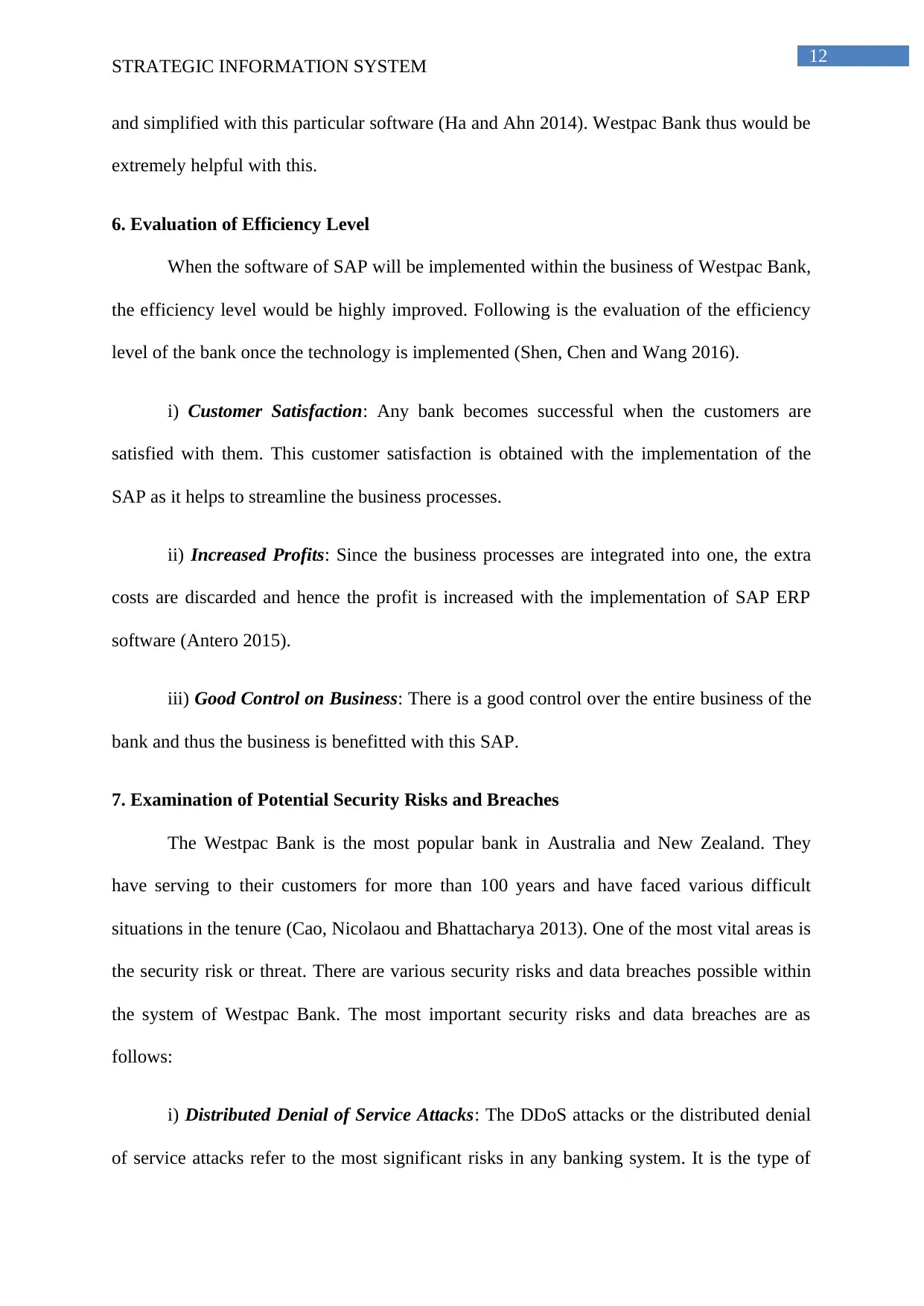
12
STRATEGIC INFORMATION SYSTEM
and simplified with this particular software (Ha and Ahn 2014). Westpac Bank thus would be
extremely helpful with this.
6. Evaluation of Efficiency Level
When the software of SAP will be implemented within the business of Westpac Bank,
the efficiency level would be highly improved. Following is the evaluation of the efficiency
level of the bank once the technology is implemented (Shen, Chen and Wang 2016).
i) Customer Satisfaction: Any bank becomes successful when the customers are
satisfied with them. This customer satisfaction is obtained with the implementation of the
SAP as it helps to streamline the business processes.
ii) Increased Profits: Since the business processes are integrated into one, the extra
costs are discarded and hence the profit is increased with the implementation of SAP ERP
software (Antero 2015).
iii) Good Control on Business: There is a good control over the entire business of the
bank and thus the business is benefitted with this SAP.
7. Examination of Potential Security Risks and Breaches
The Westpac Bank is the most popular bank in Australia and New Zealand. They
have serving to their customers for more than 100 years and have faced various difficult
situations in the tenure (Cao, Nicolaou and Bhattacharya 2013). One of the most vital areas is
the security risk or threat. There are various security risks and data breaches possible within
the system of Westpac Bank. The most important security risks and data breaches are as
follows:
i) Distributed Denial of Service Attacks: The DDoS attacks or the distributed denial
of service attacks refer to the most significant risks in any banking system. It is the type of
STRATEGIC INFORMATION SYSTEM
and simplified with this particular software (Ha and Ahn 2014). Westpac Bank thus would be
extremely helpful with this.
6. Evaluation of Efficiency Level
When the software of SAP will be implemented within the business of Westpac Bank,
the efficiency level would be highly improved. Following is the evaluation of the efficiency
level of the bank once the technology is implemented (Shen, Chen and Wang 2016).
i) Customer Satisfaction: Any bank becomes successful when the customers are
satisfied with them. This customer satisfaction is obtained with the implementation of the
SAP as it helps to streamline the business processes.
ii) Increased Profits: Since the business processes are integrated into one, the extra
costs are discarded and hence the profit is increased with the implementation of SAP ERP
software (Antero 2015).
iii) Good Control on Business: There is a good control over the entire business of the
bank and thus the business is benefitted with this SAP.
7. Examination of Potential Security Risks and Breaches
The Westpac Bank is the most popular bank in Australia and New Zealand. They
have serving to their customers for more than 100 years and have faced various difficult
situations in the tenure (Cao, Nicolaou and Bhattacharya 2013). One of the most vital areas is
the security risk or threat. There are various security risks and data breaches possible within
the system of Westpac Bank. The most important security risks and data breaches are as
follows:
i) Distributed Denial of Service Attacks: The DDoS attacks or the distributed denial
of service attacks refer to the most significant risks in any banking system. It is the type of
Paraphrase This Document
Need a fresh take? Get an instant paraphrase of this document with our AI Paraphraser
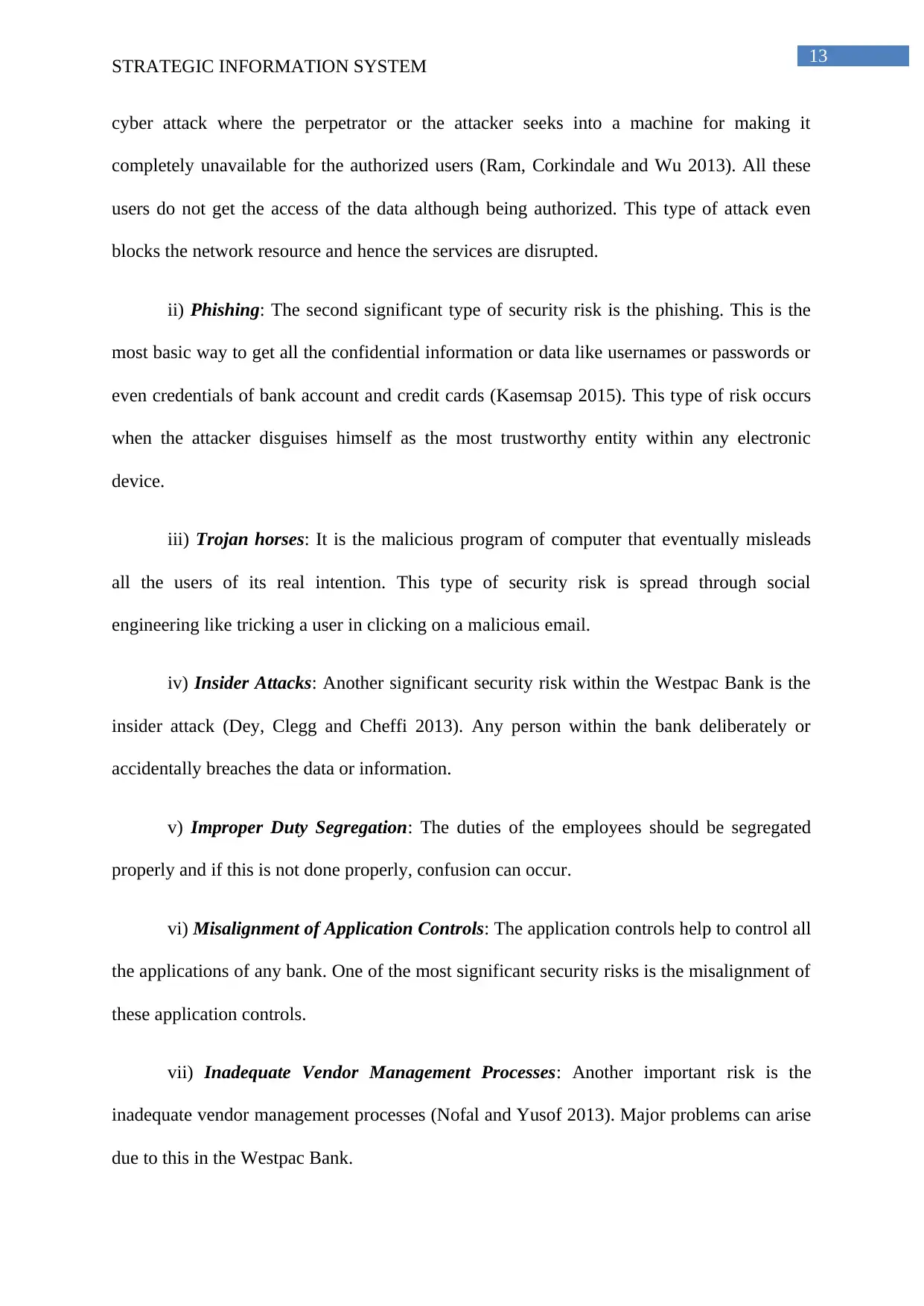
13
STRATEGIC INFORMATION SYSTEM
cyber attack where the perpetrator or the attacker seeks into a machine for making it
completely unavailable for the authorized users (Ram, Corkindale and Wu 2013). All these
users do not get the access of the data although being authorized. This type of attack even
blocks the network resource and hence the services are disrupted.
ii) Phishing: The second significant type of security risk is the phishing. This is the
most basic way to get all the confidential information or data like usernames or passwords or
even credentials of bank account and credit cards (Kasemsap 2015). This type of risk occurs
when the attacker disguises himself as the most trustworthy entity within any electronic
device.
iii) Trojan horses: It is the malicious program of computer that eventually misleads
all the users of its real intention. This type of security risk is spread through social
engineering like tricking a user in clicking on a malicious email.
iv) Insider Attacks: Another significant security risk within the Westpac Bank is the
insider attack (Dey, Clegg and Cheffi 2013). Any person within the bank deliberately or
accidentally breaches the data or information.
v) Improper Duty Segregation: The duties of the employees should be segregated
properly and if this is not done properly, confusion can occur.
vi) Misalignment of Application Controls: The application controls help to control all
the applications of any bank. One of the most significant security risks is the misalignment of
these application controls.
vii) Inadequate Vendor Management Processes: Another important risk is the
inadequate vendor management processes (Nofal and Yusof 2013). Major problems can arise
due to this in the Westpac Bank.
STRATEGIC INFORMATION SYSTEM
cyber attack where the perpetrator or the attacker seeks into a machine for making it
completely unavailable for the authorized users (Ram, Corkindale and Wu 2013). All these
users do not get the access of the data although being authorized. This type of attack even
blocks the network resource and hence the services are disrupted.
ii) Phishing: The second significant type of security risk is the phishing. This is the
most basic way to get all the confidential information or data like usernames or passwords or
even credentials of bank account and credit cards (Kasemsap 2015). This type of risk occurs
when the attacker disguises himself as the most trustworthy entity within any electronic
device.
iii) Trojan horses: It is the malicious program of computer that eventually misleads
all the users of its real intention. This type of security risk is spread through social
engineering like tricking a user in clicking on a malicious email.
iv) Insider Attacks: Another significant security risk within the Westpac Bank is the
insider attack (Dey, Clegg and Cheffi 2013). Any person within the bank deliberately or
accidentally breaches the data or information.
v) Improper Duty Segregation: The duties of the employees should be segregated
properly and if this is not done properly, confusion can occur.
vi) Misalignment of Application Controls: The application controls help to control all
the applications of any bank. One of the most significant security risks is the misalignment of
these application controls.
vii) Inadequate Vendor Management Processes: Another important risk is the
inadequate vendor management processes (Nofal and Yusof 2013). Major problems can arise
due to this in the Westpac Bank.
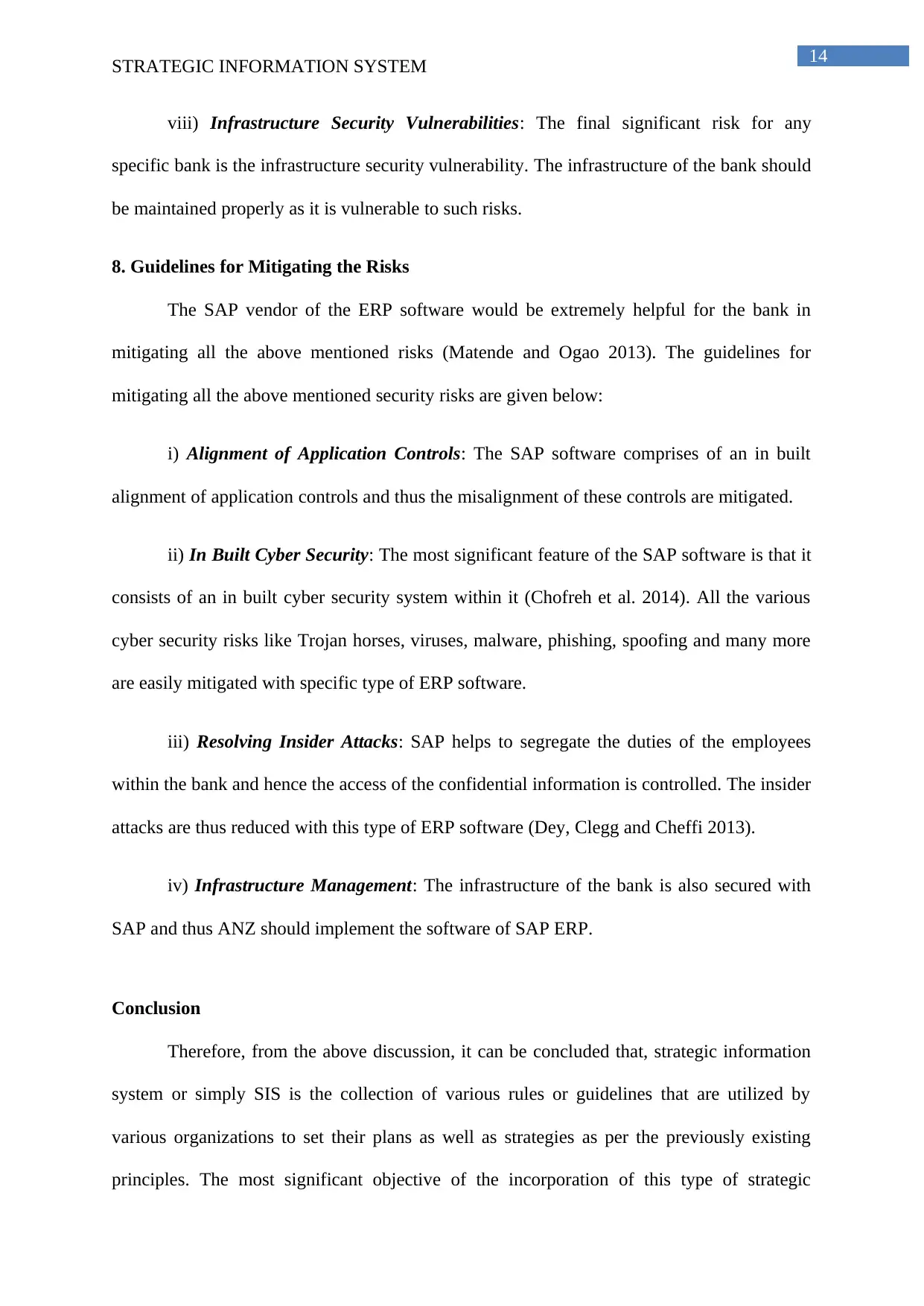
14
STRATEGIC INFORMATION SYSTEM
viii) Infrastructure Security Vulnerabilities: The final significant risk for any
specific bank is the infrastructure security vulnerability. The infrastructure of the bank should
be maintained properly as it is vulnerable to such risks.
8. Guidelines for Mitigating the Risks
The SAP vendor of the ERP software would be extremely helpful for the bank in
mitigating all the above mentioned risks (Matende and Ogao 2013). The guidelines for
mitigating all the above mentioned security risks are given below:
i) Alignment of Application Controls: The SAP software comprises of an in built
alignment of application controls and thus the misalignment of these controls are mitigated.
ii) In Built Cyber Security: The most significant feature of the SAP software is that it
consists of an in built cyber security system within it (Chofreh et al. 2014). All the various
cyber security risks like Trojan horses, viruses, malware, phishing, spoofing and many more
are easily mitigated with specific type of ERP software.
iii) Resolving Insider Attacks: SAP helps to segregate the duties of the employees
within the bank and hence the access of the confidential information is controlled. The insider
attacks are thus reduced with this type of ERP software (Dey, Clegg and Cheffi 2013).
iv) Infrastructure Management: The infrastructure of the bank is also secured with
SAP and thus ANZ should implement the software of SAP ERP.
Conclusion
Therefore, from the above discussion, it can be concluded that, strategic information
system or simply SIS is the collection of various rules or guidelines that are utilized by
various organizations to set their plans as well as strategies as per the previously existing
principles. The most significant objective of the incorporation of this type of strategic
STRATEGIC INFORMATION SYSTEM
viii) Infrastructure Security Vulnerabilities: The final significant risk for any
specific bank is the infrastructure security vulnerability. The infrastructure of the bank should
be maintained properly as it is vulnerable to such risks.
8. Guidelines for Mitigating the Risks
The SAP vendor of the ERP software would be extremely helpful for the bank in
mitigating all the above mentioned risks (Matende and Ogao 2013). The guidelines for
mitigating all the above mentioned security risks are given below:
i) Alignment of Application Controls: The SAP software comprises of an in built
alignment of application controls and thus the misalignment of these controls are mitigated.
ii) In Built Cyber Security: The most significant feature of the SAP software is that it
consists of an in built cyber security system within it (Chofreh et al. 2014). All the various
cyber security risks like Trojan horses, viruses, malware, phishing, spoofing and many more
are easily mitigated with specific type of ERP software.
iii) Resolving Insider Attacks: SAP helps to segregate the duties of the employees
within the bank and hence the access of the confidential information is controlled. The insider
attacks are thus reduced with this type of ERP software (Dey, Clegg and Cheffi 2013).
iv) Infrastructure Management: The infrastructure of the bank is also secured with
SAP and thus ANZ should implement the software of SAP ERP.
Conclusion
Therefore, from the above discussion, it can be concluded that, strategic information
system or simply SIS is the collection of various rules or guidelines that are utilized by
various organizations to set their plans as well as strategies as per the previously existing
principles. The most significant objective of the incorporation of this type of strategic
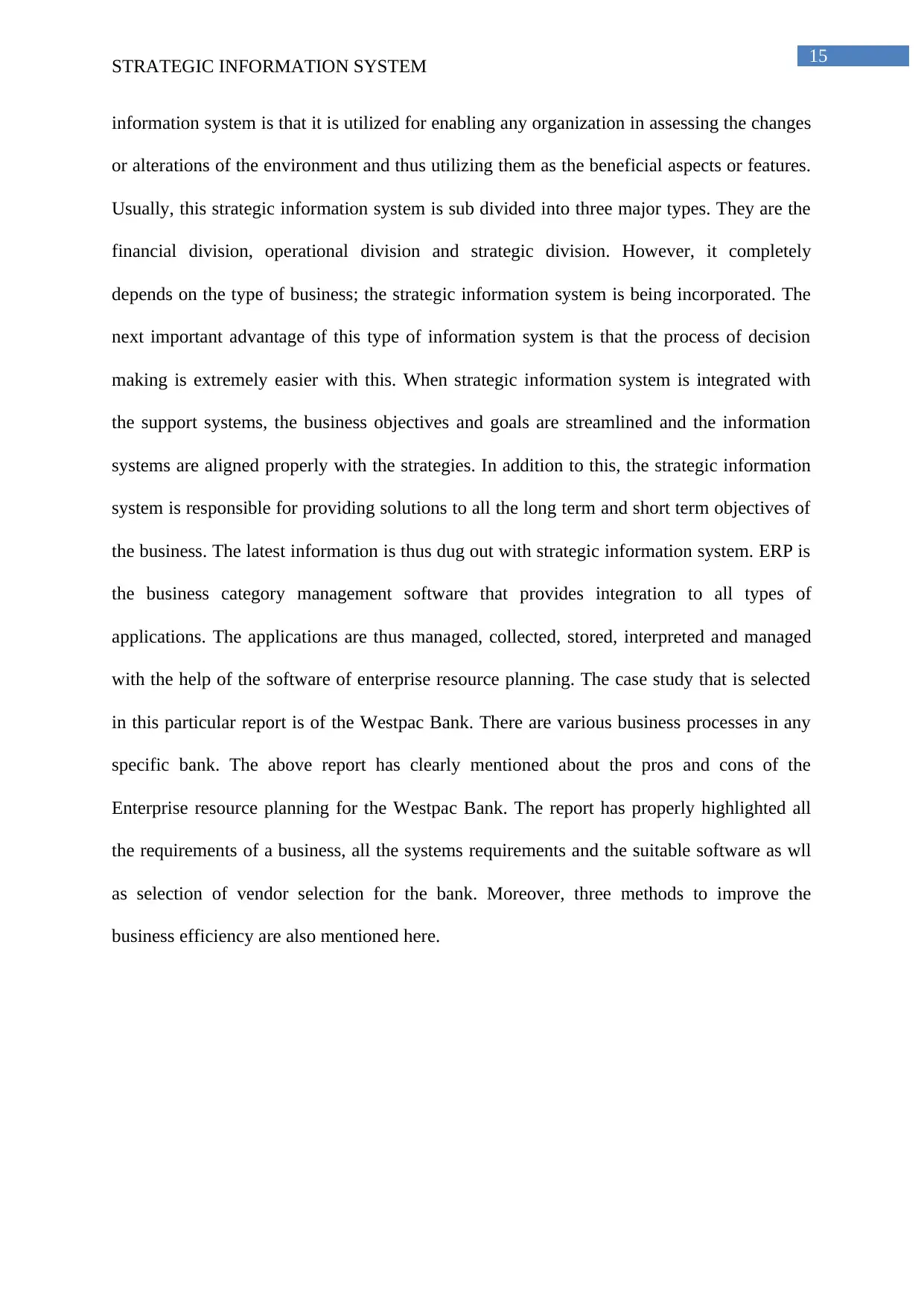
15
STRATEGIC INFORMATION SYSTEM
information system is that it is utilized for enabling any organization in assessing the changes
or alterations of the environment and thus utilizing them as the beneficial aspects or features.
Usually, this strategic information system is sub divided into three major types. They are the
financial division, operational division and strategic division. However, it completely
depends on the type of business; the strategic information system is being incorporated. The
next important advantage of this type of information system is that the process of decision
making is extremely easier with this. When strategic information system is integrated with
the support systems, the business objectives and goals are streamlined and the information
systems are aligned properly with the strategies. In addition to this, the strategic information
system is responsible for providing solutions to all the long term and short term objectives of
the business. The latest information is thus dug out with strategic information system. ERP is
the business category management software that provides integration to all types of
applications. The applications are thus managed, collected, stored, interpreted and managed
with the help of the software of enterprise resource planning. The case study that is selected
in this particular report is of the Westpac Bank. There are various business processes in any
specific bank. The above report has clearly mentioned about the pros and cons of the
Enterprise resource planning for the Westpac Bank. The report has properly highlighted all
the requirements of a business, all the systems requirements and the suitable software as wll
as selection of vendor selection for the bank. Moreover, three methods to improve the
business efficiency are also mentioned here.
STRATEGIC INFORMATION SYSTEM
information system is that it is utilized for enabling any organization in assessing the changes
or alterations of the environment and thus utilizing them as the beneficial aspects or features.
Usually, this strategic information system is sub divided into three major types. They are the
financial division, operational division and strategic division. However, it completely
depends on the type of business; the strategic information system is being incorporated. The
next important advantage of this type of information system is that the process of decision
making is extremely easier with this. When strategic information system is integrated with
the support systems, the business objectives and goals are streamlined and the information
systems are aligned properly with the strategies. In addition to this, the strategic information
system is responsible for providing solutions to all the long term and short term objectives of
the business. The latest information is thus dug out with strategic information system. ERP is
the business category management software that provides integration to all types of
applications. The applications are thus managed, collected, stored, interpreted and managed
with the help of the software of enterprise resource planning. The case study that is selected
in this particular report is of the Westpac Bank. There are various business processes in any
specific bank. The above report has clearly mentioned about the pros and cons of the
Enterprise resource planning for the Westpac Bank. The report has properly highlighted all
the requirements of a business, all the systems requirements and the suitable software as wll
as selection of vendor selection for the bank. Moreover, three methods to improve the
business efficiency are also mentioned here.
Secure Best Marks with AI Grader
Need help grading? Try our AI Grader for instant feedback on your assignments.
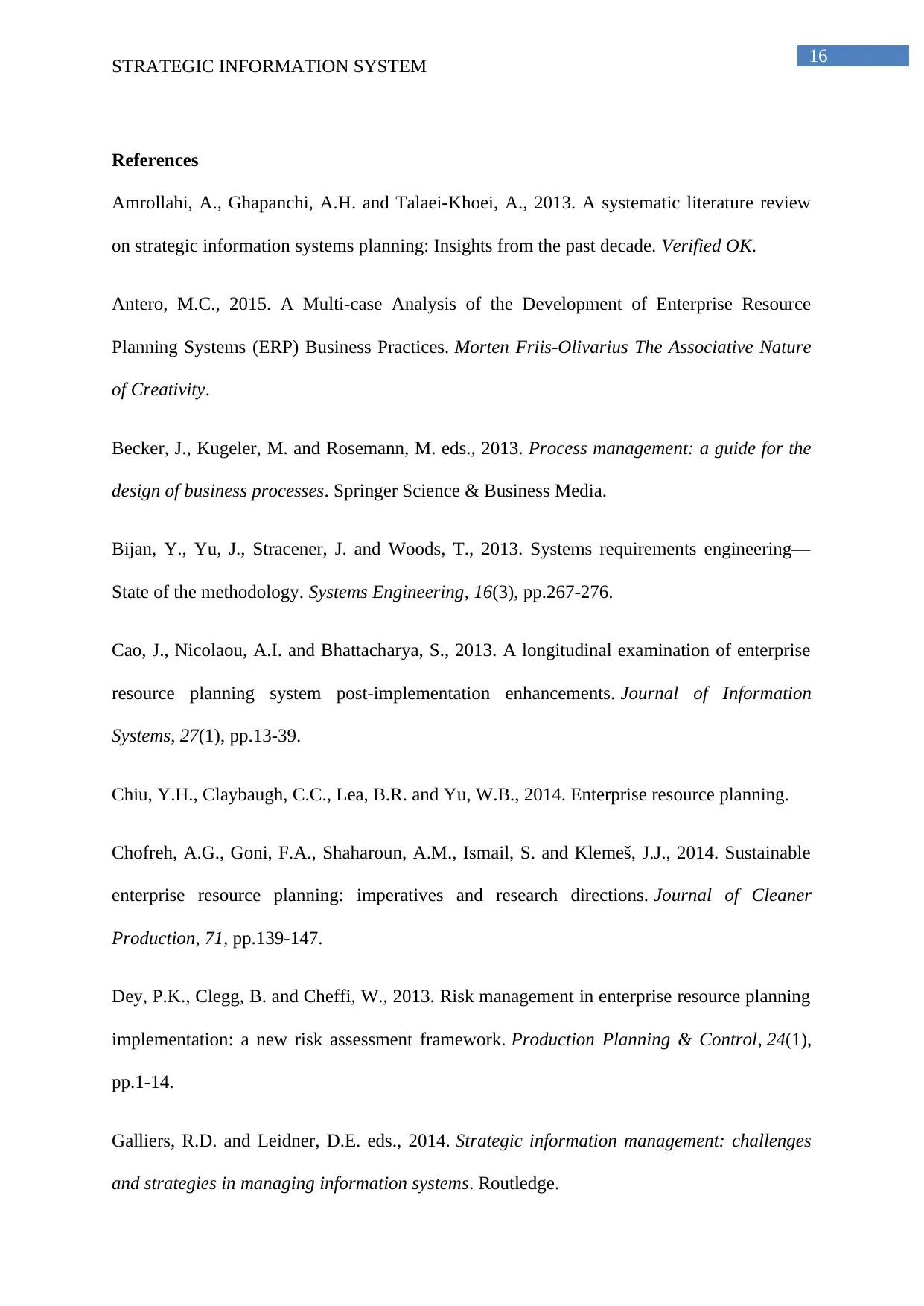
16
STRATEGIC INFORMATION SYSTEM
References
Amrollahi, A., Ghapanchi, A.H. and Talaei-Khoei, A., 2013. A systematic literature review
on strategic information systems planning: Insights from the past decade. Verified OK.
Antero, M.C., 2015. A Multi-case Analysis of the Development of Enterprise Resource
Planning Systems (ERP) Business Practices. Morten Friis-Olivarius The Associative Nature
of Creativity.
Becker, J., Kugeler, M. and Rosemann, M. eds., 2013. Process management: a guide for the
design of business processes. Springer Science & Business Media.
Bijan, Y., Yu, J., Stracener, J. and Woods, T., 2013. Systems requirements engineering—
State of the methodology. Systems Engineering, 16(3), pp.267-276.
Cao, J., Nicolaou, A.I. and Bhattacharya, S., 2013. A longitudinal examination of enterprise
resource planning system post-implementation enhancements. Journal of Information
Systems, 27(1), pp.13-39.
Chiu, Y.H., Claybaugh, C.C., Lea, B.R. and Yu, W.B., 2014. Enterprise resource planning.
Chofreh, A.G., Goni, F.A., Shaharoun, A.M., Ismail, S. and Klemeš, J.J., 2014. Sustainable
enterprise resource planning: imperatives and research directions. Journal of Cleaner
Production, 71, pp.139-147.
Dey, P.K., Clegg, B. and Cheffi, W., 2013. Risk management in enterprise resource planning
implementation: a new risk assessment framework. Production Planning & Control, 24(1),
pp.1-14.
Galliers, R.D. and Leidner, D.E. eds., 2014. Strategic information management: challenges
and strategies in managing information systems. Routledge.
STRATEGIC INFORMATION SYSTEM
References
Amrollahi, A., Ghapanchi, A.H. and Talaei-Khoei, A., 2013. A systematic literature review
on strategic information systems planning: Insights from the past decade. Verified OK.
Antero, M.C., 2015. A Multi-case Analysis of the Development of Enterprise Resource
Planning Systems (ERP) Business Practices. Morten Friis-Olivarius The Associative Nature
of Creativity.
Becker, J., Kugeler, M. and Rosemann, M. eds., 2013. Process management: a guide for the
design of business processes. Springer Science & Business Media.
Bijan, Y., Yu, J., Stracener, J. and Woods, T., 2013. Systems requirements engineering—
State of the methodology. Systems Engineering, 16(3), pp.267-276.
Cao, J., Nicolaou, A.I. and Bhattacharya, S., 2013. A longitudinal examination of enterprise
resource planning system post-implementation enhancements. Journal of Information
Systems, 27(1), pp.13-39.
Chiu, Y.H., Claybaugh, C.C., Lea, B.R. and Yu, W.B., 2014. Enterprise resource planning.
Chofreh, A.G., Goni, F.A., Shaharoun, A.M., Ismail, S. and Klemeš, J.J., 2014. Sustainable
enterprise resource planning: imperatives and research directions. Journal of Cleaner
Production, 71, pp.139-147.
Dey, P.K., Clegg, B. and Cheffi, W., 2013. Risk management in enterprise resource planning
implementation: a new risk assessment framework. Production Planning & Control, 24(1),
pp.1-14.
Galliers, R.D. and Leidner, D.E. eds., 2014. Strategic information management: challenges
and strategies in managing information systems. Routledge.
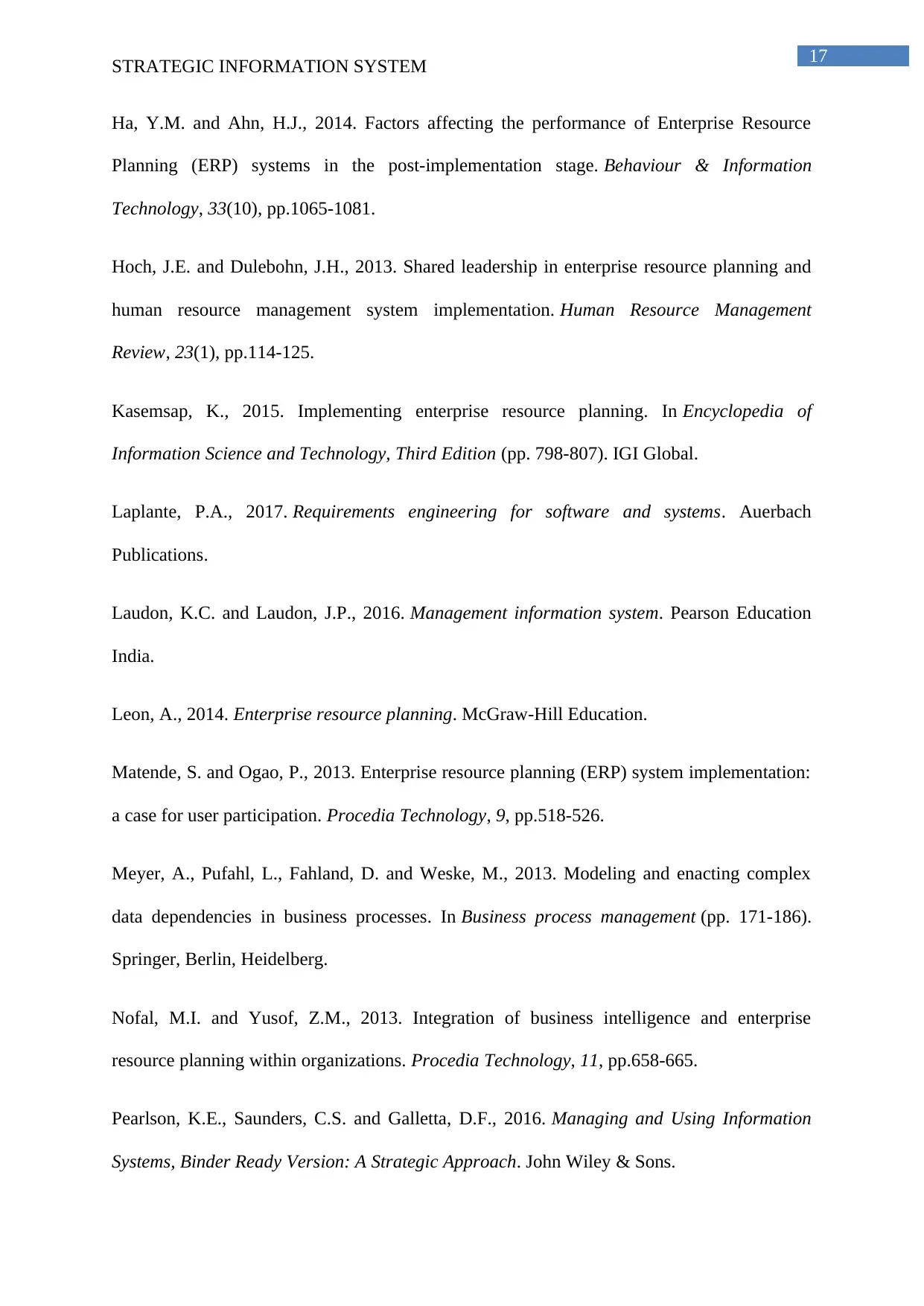
17
STRATEGIC INFORMATION SYSTEM
Ha, Y.M. and Ahn, H.J., 2014. Factors affecting the performance of Enterprise Resource
Planning (ERP) systems in the post-implementation stage. Behaviour & Information
Technology, 33(10), pp.1065-1081.
Hoch, J.E. and Dulebohn, J.H., 2013. Shared leadership in enterprise resource planning and
human resource management system implementation. Human Resource Management
Review, 23(1), pp.114-125.
Kasemsap, K., 2015. Implementing enterprise resource planning. In Encyclopedia of
Information Science and Technology, Third Edition (pp. 798-807). IGI Global.
Laplante, P.A., 2017. Requirements engineering for software and systems. Auerbach
Publications.
Laudon, K.C. and Laudon, J.P., 2016. Management information system. Pearson Education
India.
Leon, A., 2014. Enterprise resource planning. McGraw-Hill Education.
Matende, S. and Ogao, P., 2013. Enterprise resource planning (ERP) system implementation:
a case for user participation. Procedia Technology, 9, pp.518-526.
Meyer, A., Pufahl, L., Fahland, D. and Weske, M., 2013. Modeling and enacting complex
data dependencies in business processes. In Business process management (pp. 171-186).
Springer, Berlin, Heidelberg.
Nofal, M.I. and Yusof, Z.M., 2013. Integration of business intelligence and enterprise
resource planning within organizations. Procedia Technology, 11, pp.658-665.
Pearlson, K.E., Saunders, C.S. and Galletta, D.F., 2016. Managing and Using Information
Systems, Binder Ready Version: A Strategic Approach. John Wiley & Sons.
STRATEGIC INFORMATION SYSTEM
Ha, Y.M. and Ahn, H.J., 2014. Factors affecting the performance of Enterprise Resource
Planning (ERP) systems in the post-implementation stage. Behaviour & Information
Technology, 33(10), pp.1065-1081.
Hoch, J.E. and Dulebohn, J.H., 2013. Shared leadership in enterprise resource planning and
human resource management system implementation. Human Resource Management
Review, 23(1), pp.114-125.
Kasemsap, K., 2015. Implementing enterprise resource planning. In Encyclopedia of
Information Science and Technology, Third Edition (pp. 798-807). IGI Global.
Laplante, P.A., 2017. Requirements engineering for software and systems. Auerbach
Publications.
Laudon, K.C. and Laudon, J.P., 2016. Management information system. Pearson Education
India.
Leon, A., 2014. Enterprise resource planning. McGraw-Hill Education.
Matende, S. and Ogao, P., 2013. Enterprise resource planning (ERP) system implementation:
a case for user participation. Procedia Technology, 9, pp.518-526.
Meyer, A., Pufahl, L., Fahland, D. and Weske, M., 2013. Modeling and enacting complex
data dependencies in business processes. In Business process management (pp. 171-186).
Springer, Berlin, Heidelberg.
Nofal, M.I. and Yusof, Z.M., 2013. Integration of business intelligence and enterprise
resource planning within organizations. Procedia Technology, 11, pp.658-665.
Pearlson, K.E., Saunders, C.S. and Galletta, D.F., 2016. Managing and Using Information
Systems, Binder Ready Version: A Strategic Approach. John Wiley & Sons.
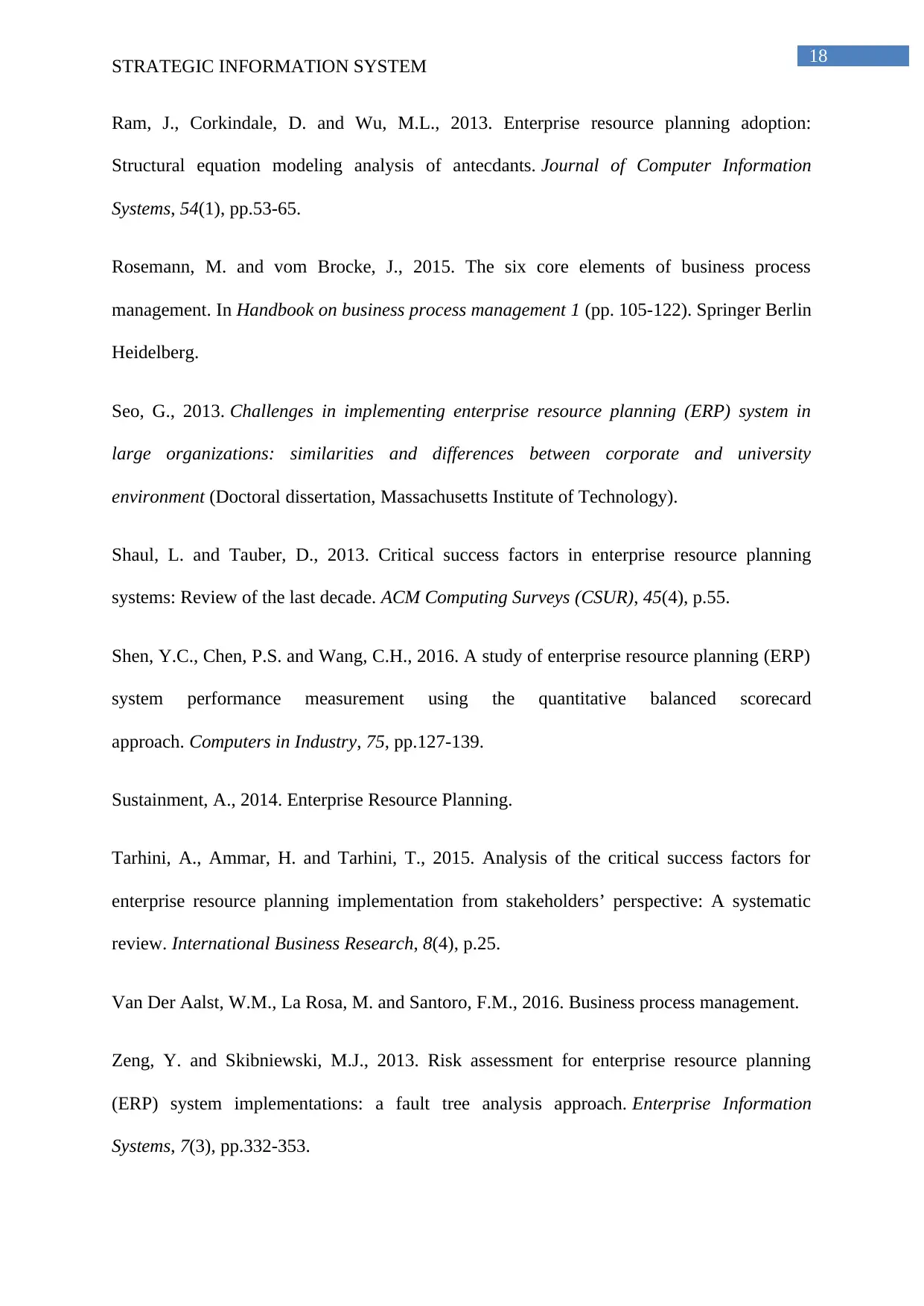
18
STRATEGIC INFORMATION SYSTEM
Ram, J., Corkindale, D. and Wu, M.L., 2013. Enterprise resource planning adoption:
Structural equation modeling analysis of antecdants. Journal of Computer Information
Systems, 54(1), pp.53-65.
Rosemann, M. and vom Brocke, J., 2015. The six core elements of business process
management. In Handbook on business process management 1 (pp. 105-122). Springer Berlin
Heidelberg.
Seo, G., 2013. Challenges in implementing enterprise resource planning (ERP) system in
large organizations: similarities and differences between corporate and university
environment (Doctoral dissertation, Massachusetts Institute of Technology).
Shaul, L. and Tauber, D., 2013. Critical success factors in enterprise resource planning
systems: Review of the last decade. ACM Computing Surveys (CSUR), 45(4), p.55.
Shen, Y.C., Chen, P.S. and Wang, C.H., 2016. A study of enterprise resource planning (ERP)
system performance measurement using the quantitative balanced scorecard
approach. Computers in Industry, 75, pp.127-139.
Sustainment, A., 2014. Enterprise Resource Planning.
Tarhini, A., Ammar, H. and Tarhini, T., 2015. Analysis of the critical success factors for
enterprise resource planning implementation from stakeholders’ perspective: A systematic
review. International Business Research, 8(4), p.25.
Van Der Aalst, W.M., La Rosa, M. and Santoro, F.M., 2016. Business process management.
Zeng, Y. and Skibniewski, M.J., 2013. Risk assessment for enterprise resource planning
(ERP) system implementations: a fault tree analysis approach. Enterprise Information
Systems, 7(3), pp.332-353.
STRATEGIC INFORMATION SYSTEM
Ram, J., Corkindale, D. and Wu, M.L., 2013. Enterprise resource planning adoption:
Structural equation modeling analysis of antecdants. Journal of Computer Information
Systems, 54(1), pp.53-65.
Rosemann, M. and vom Brocke, J., 2015. The six core elements of business process
management. In Handbook on business process management 1 (pp. 105-122). Springer Berlin
Heidelberg.
Seo, G., 2013. Challenges in implementing enterprise resource planning (ERP) system in
large organizations: similarities and differences between corporate and university
environment (Doctoral dissertation, Massachusetts Institute of Technology).
Shaul, L. and Tauber, D., 2013. Critical success factors in enterprise resource planning
systems: Review of the last decade. ACM Computing Surveys (CSUR), 45(4), p.55.
Shen, Y.C., Chen, P.S. and Wang, C.H., 2016. A study of enterprise resource planning (ERP)
system performance measurement using the quantitative balanced scorecard
approach. Computers in Industry, 75, pp.127-139.
Sustainment, A., 2014. Enterprise Resource Planning.
Tarhini, A., Ammar, H. and Tarhini, T., 2015. Analysis of the critical success factors for
enterprise resource planning implementation from stakeholders’ perspective: A systematic
review. International Business Research, 8(4), p.25.
Van Der Aalst, W.M., La Rosa, M. and Santoro, F.M., 2016. Business process management.
Zeng, Y. and Skibniewski, M.J., 2013. Risk assessment for enterprise resource planning
(ERP) system implementations: a fault tree analysis approach. Enterprise Information
Systems, 7(3), pp.332-353.
1 out of 19
Related Documents
Your All-in-One AI-Powered Toolkit for Academic Success.
+13062052269
info@desklib.com
Available 24*7 on WhatsApp / Email
![[object Object]](/_next/static/media/star-bottom.7253800d.svg)
Unlock your academic potential
© 2024 | Zucol Services PVT LTD | All rights reserved.




